Discover the charm of vintage and antique yellow ware with decorative techniques, classic blue stripes, and expert styling tips. Learn how to start your own yellowware collection, display ideas, and the history behind these timeless pottery pieces.
American yellow ware has a rich history, with its warm golden hues and classic designs making it a favorite among collectors.
Popular in the early 20th century, this durable pottery was both functional and decorative, often featuring signature brown, white, red, or blue stripes and other charming details.
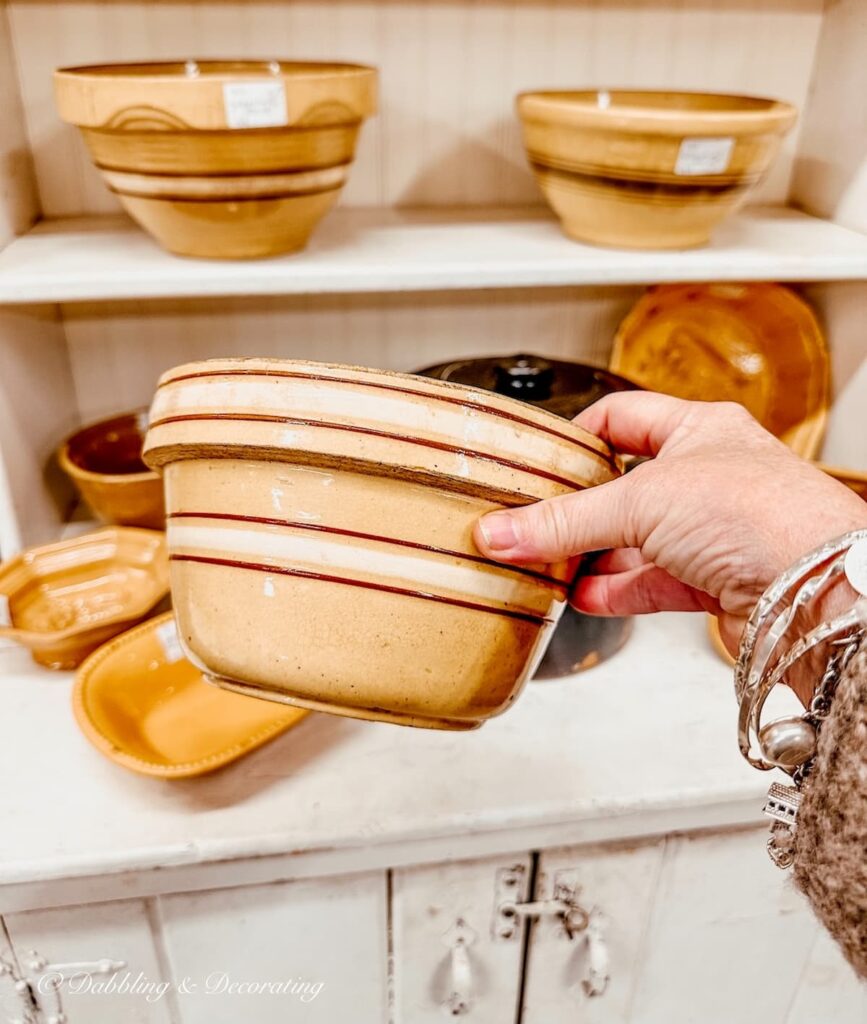
American Yellow Ware
American yellow ware emerged in the mid-19th century, inspired by English yellow ware but crafted with locally sourced clay.
This antique and vintage pottery is known for its warm, golden hue and was widely produced for everyday kitchen use.
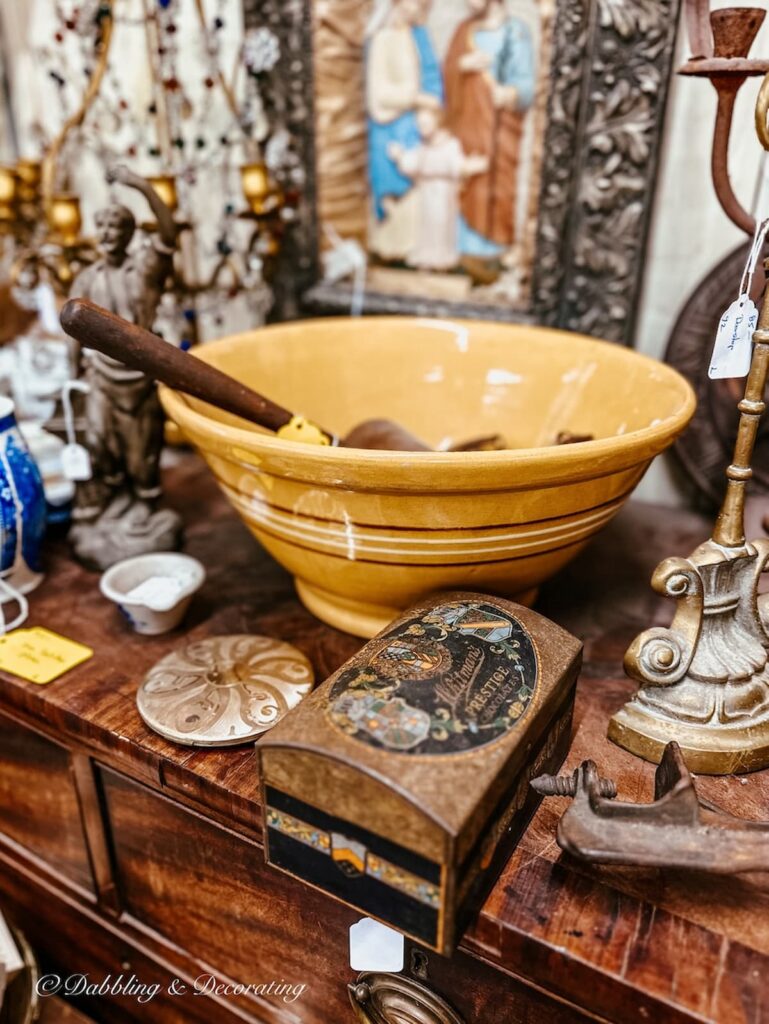
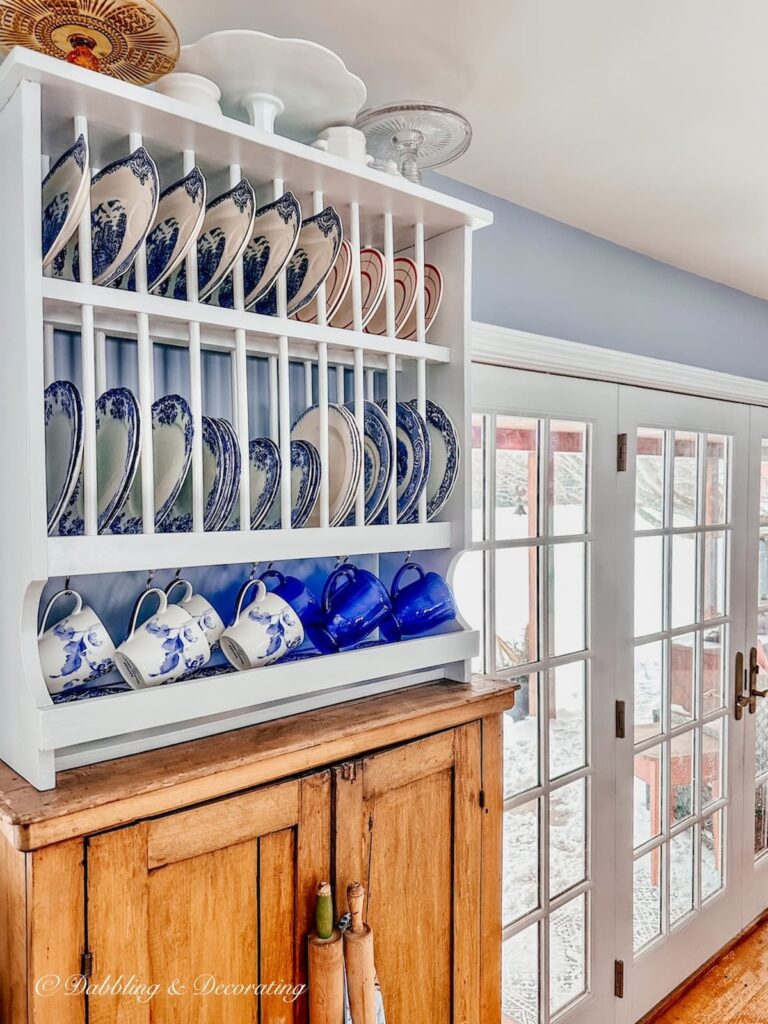
Pro Tip
You may find more inspiration in this How to Style Eclectic Interiors with Timeless Style post.
One of its most recognizable features is the addition of white stripes or creamy white bands, which were often applied using slip decoration techniques.
The handmade process varied by region and potter, with some pieces displaying smooth, refined finishes while others retained a more rustic charm.
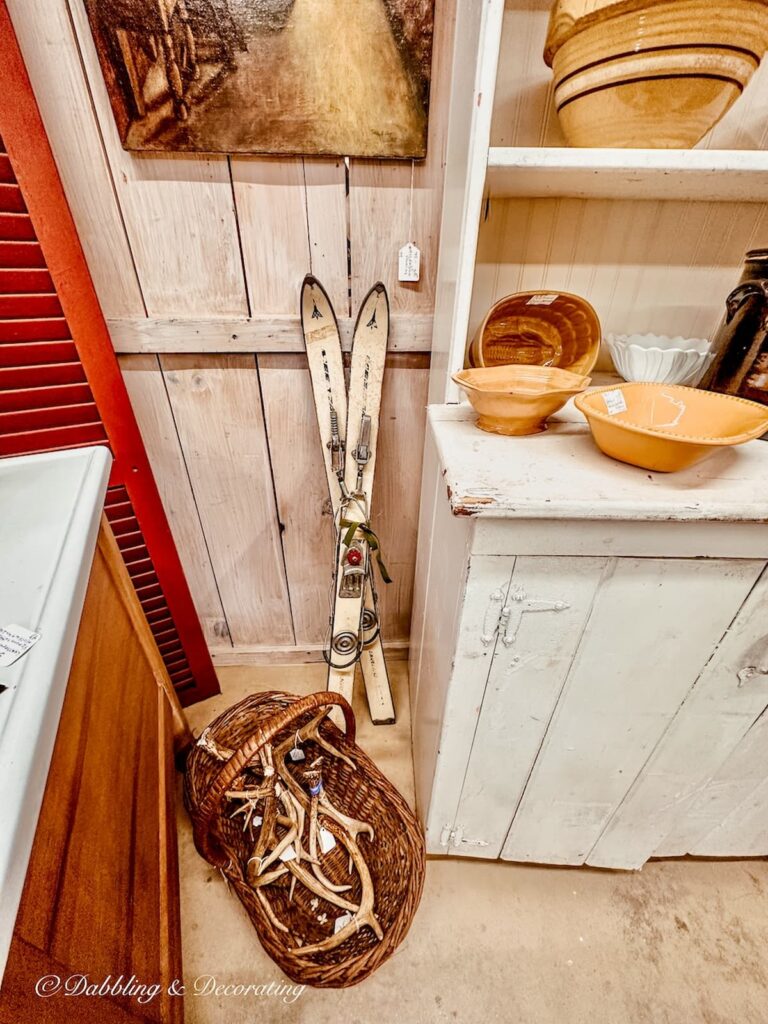
How do you spell yellow ware or yellowware?
Ah, the age-old debate—yellowware or yellow ware? Officially, it’s yellowware (one word), but since Google tells me that many people search for both yellowware and yellow ware separately, I’m embracing both spellings today. Consider it a little vintage charm meets modern search trends! So, throughout this post, you’ll see me using them interchangeably—just know that no matter how you spell it, this timeless pottery is always a collector’s favorite.
Among the most sought-after pieces today are the large bowls, which were essential in American kitchens for mixing and baking.
As the production of yellow ware expanded, different decorative techniques, including molded patterns and colored glazes, were introduced, making each piece unique and highly collectible.
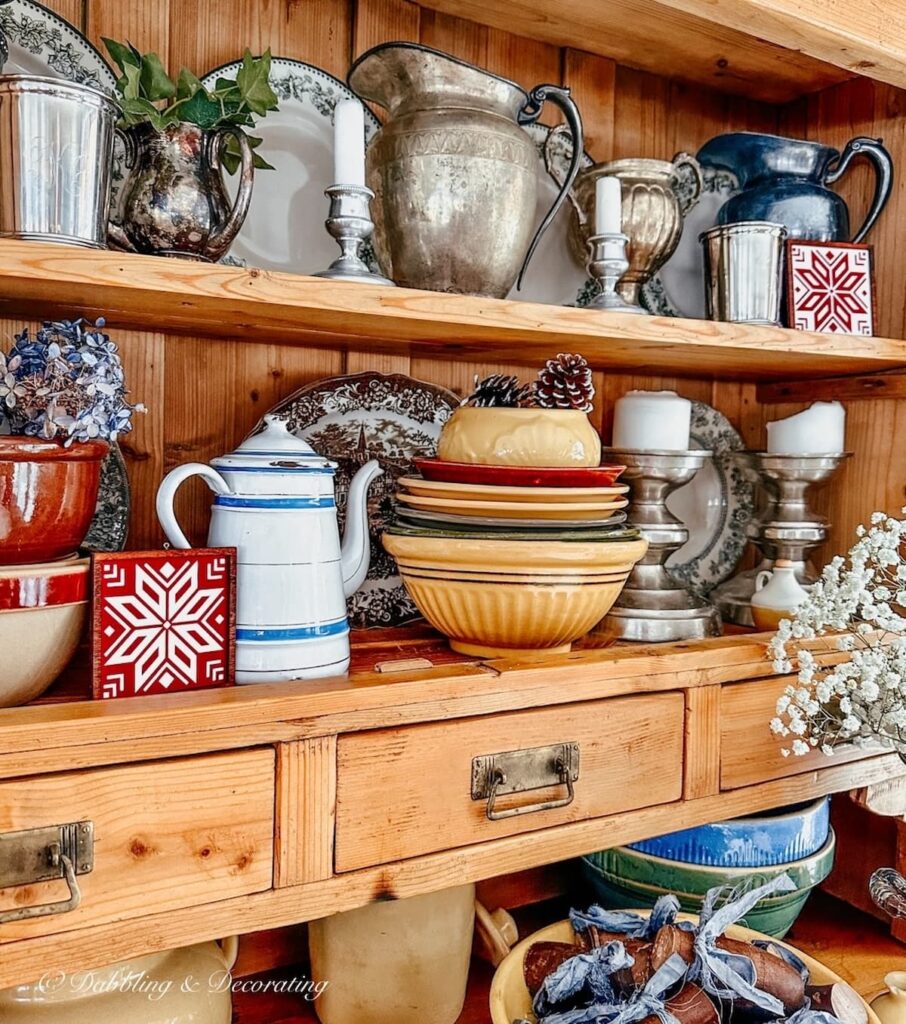
Want to Learn More About Yelloware?
Purchase This Collector’s Guide to Yellow Ware: Book I, An Identification & Value Guide
Ten years ago authors Lisa McAllister and John Michel brought collectors the definitive guide to collecting American yellow ware…
Exceptional McCoy
McCoy pottery has been a household name since 1848, crafting everything from planters to cookie jars—and yes, even yellowware!
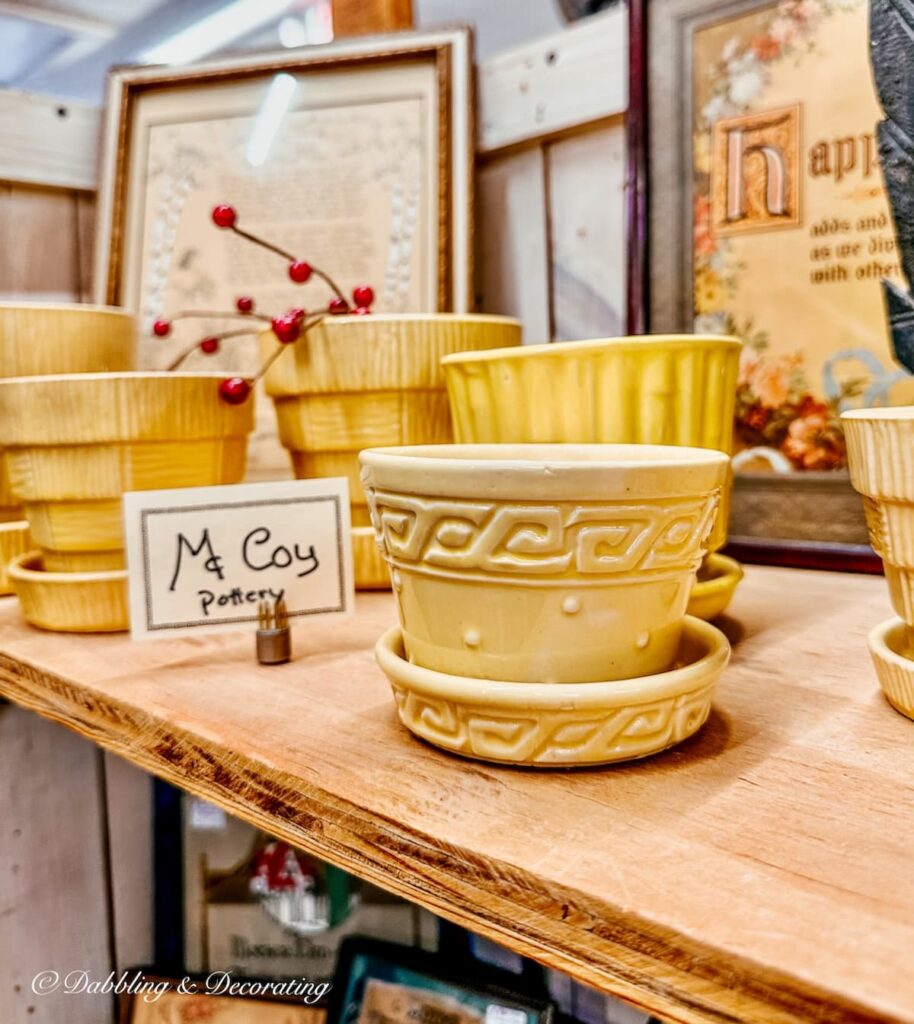
In the late 19th and early 20th centuries, McCoy jumped on the yellowware trend, creating pieces with that signature golden hue and creamy white bands that once lined American kitchen shelves.
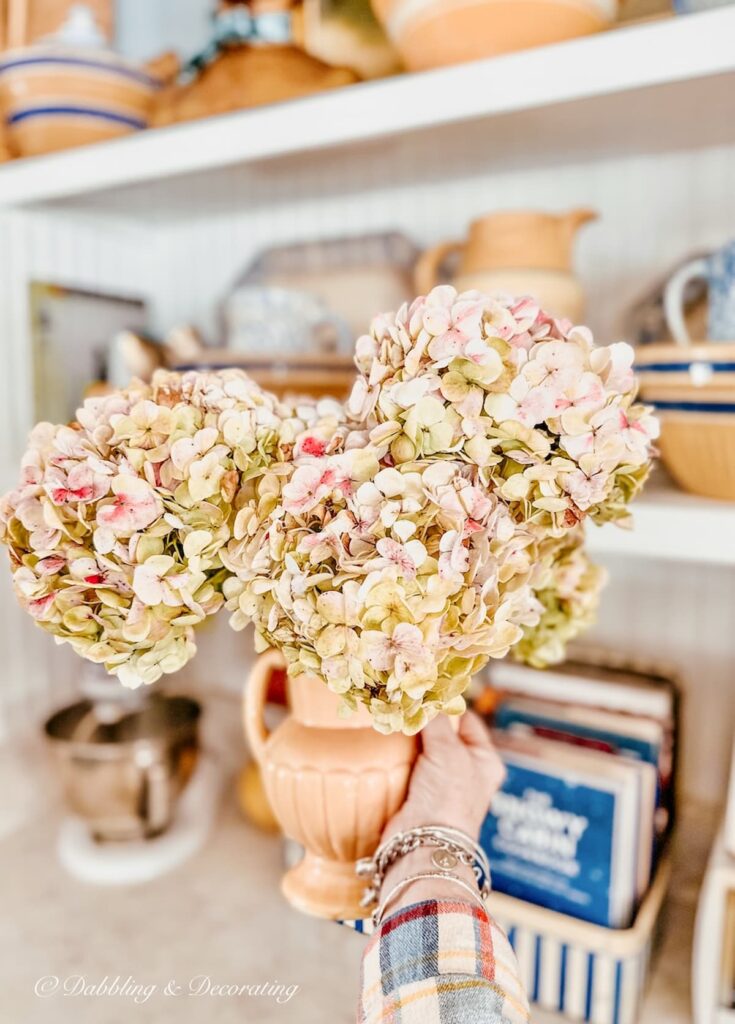
Today, vintage McCoy yellowware is a collector’s dream, blending farmhouse charm with the timeless appeal of well-loved pottery.
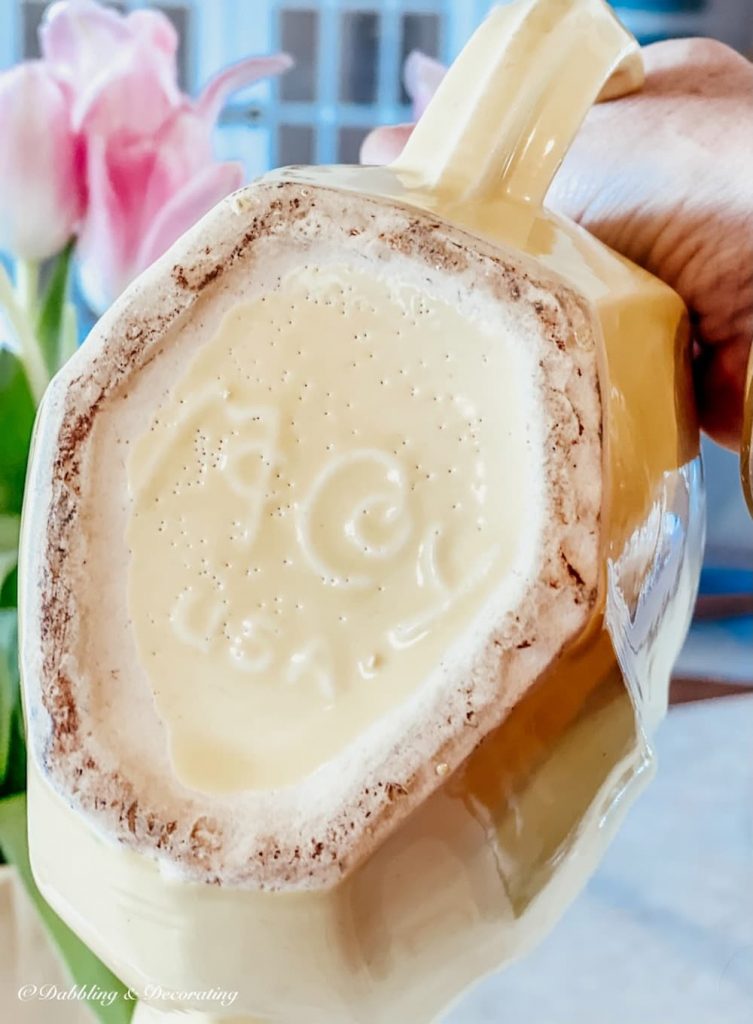
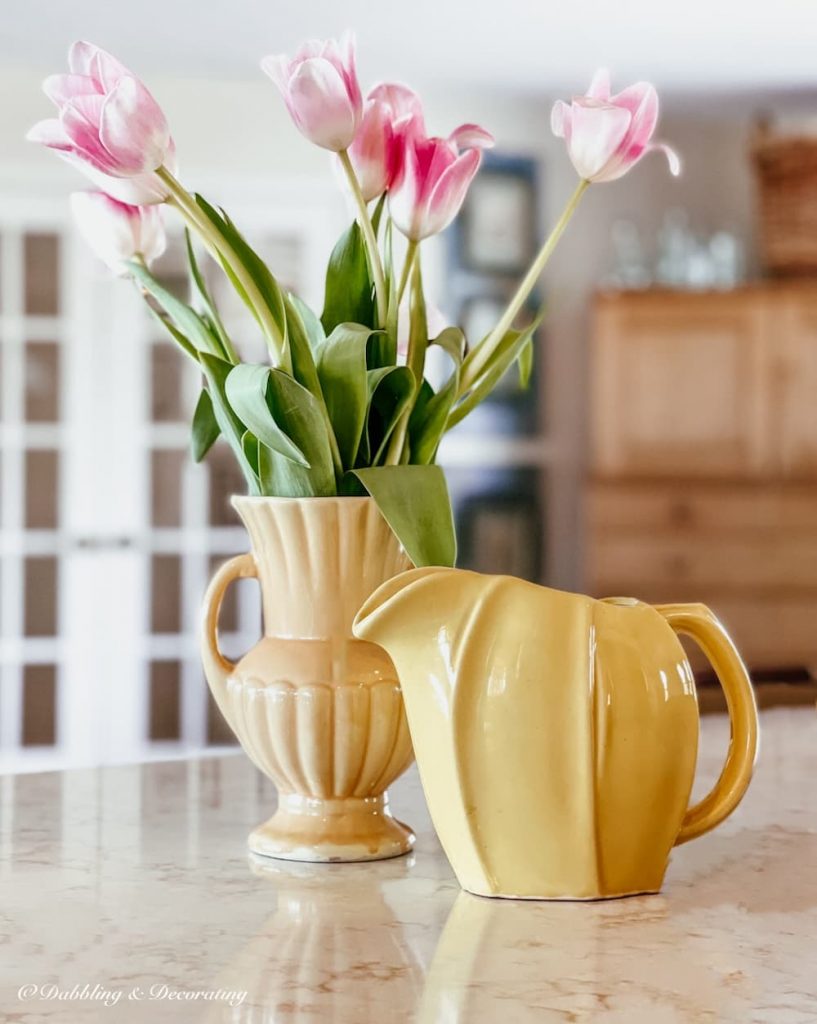
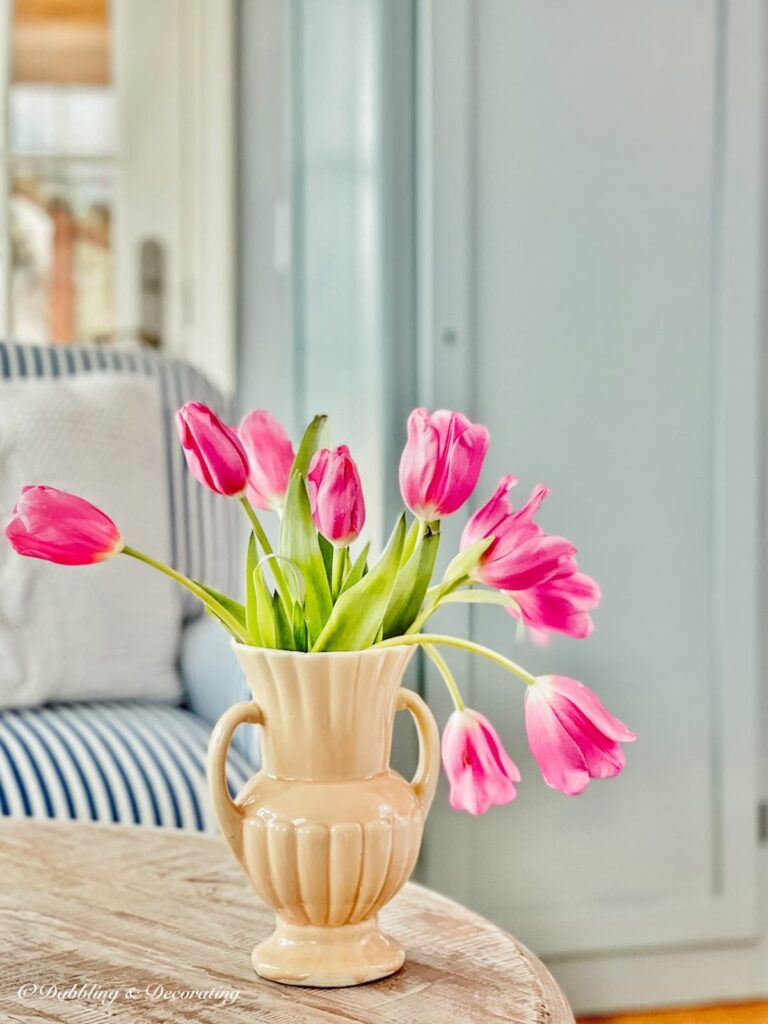
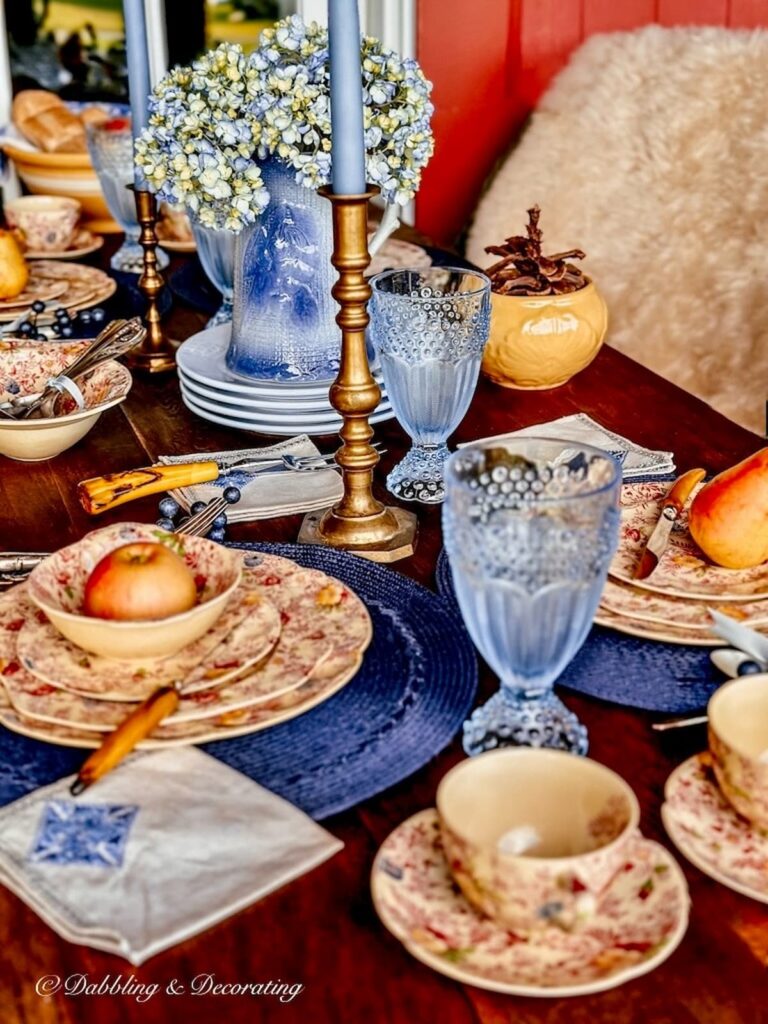
Pro Tip
You may also enjoy this How to Create a Stunning Tablescape You’ll Love post with a vintage Chintz dinnerware pattern.
Yellow Ware Decorative Techniques
Yellowware isn’t just about its creamy yellow hue—it’s the decorative details that make each piece a treasure!
From striped bands to spattered glazes, embossed patterns, and rare seaweed designs, these slight variations add character and charm, making every flea market or antique store find an exciting addition to your collection.
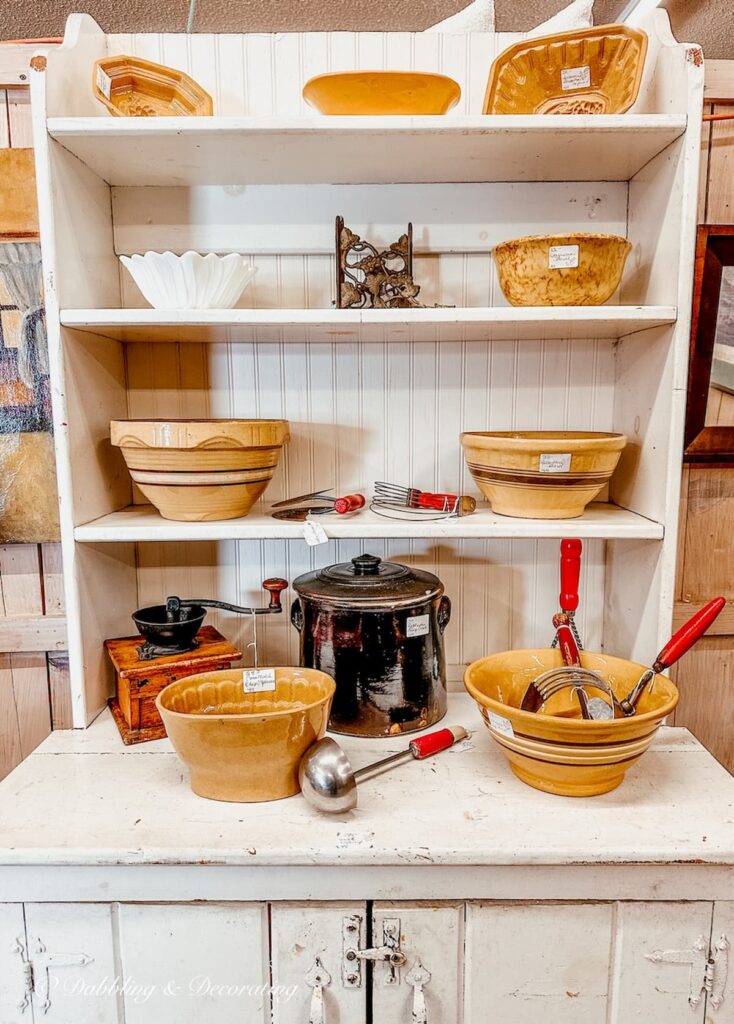
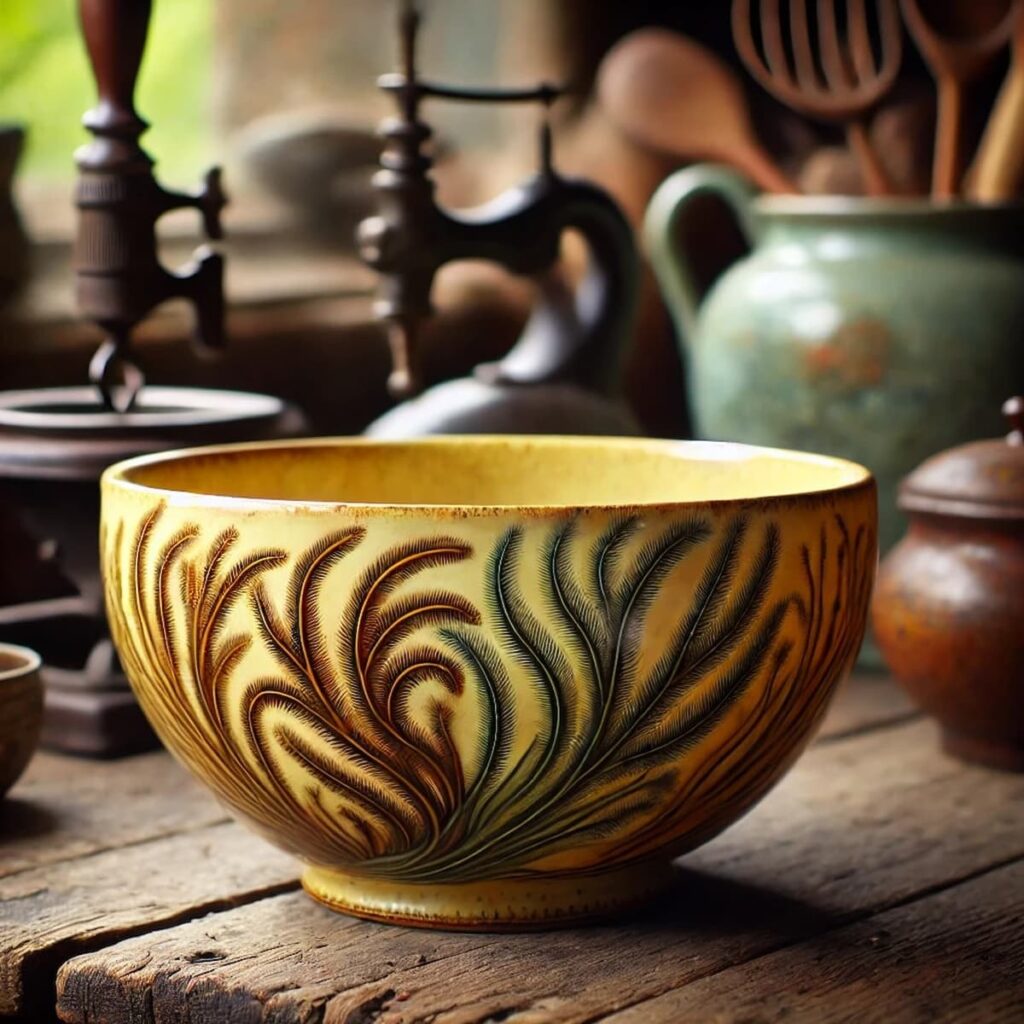
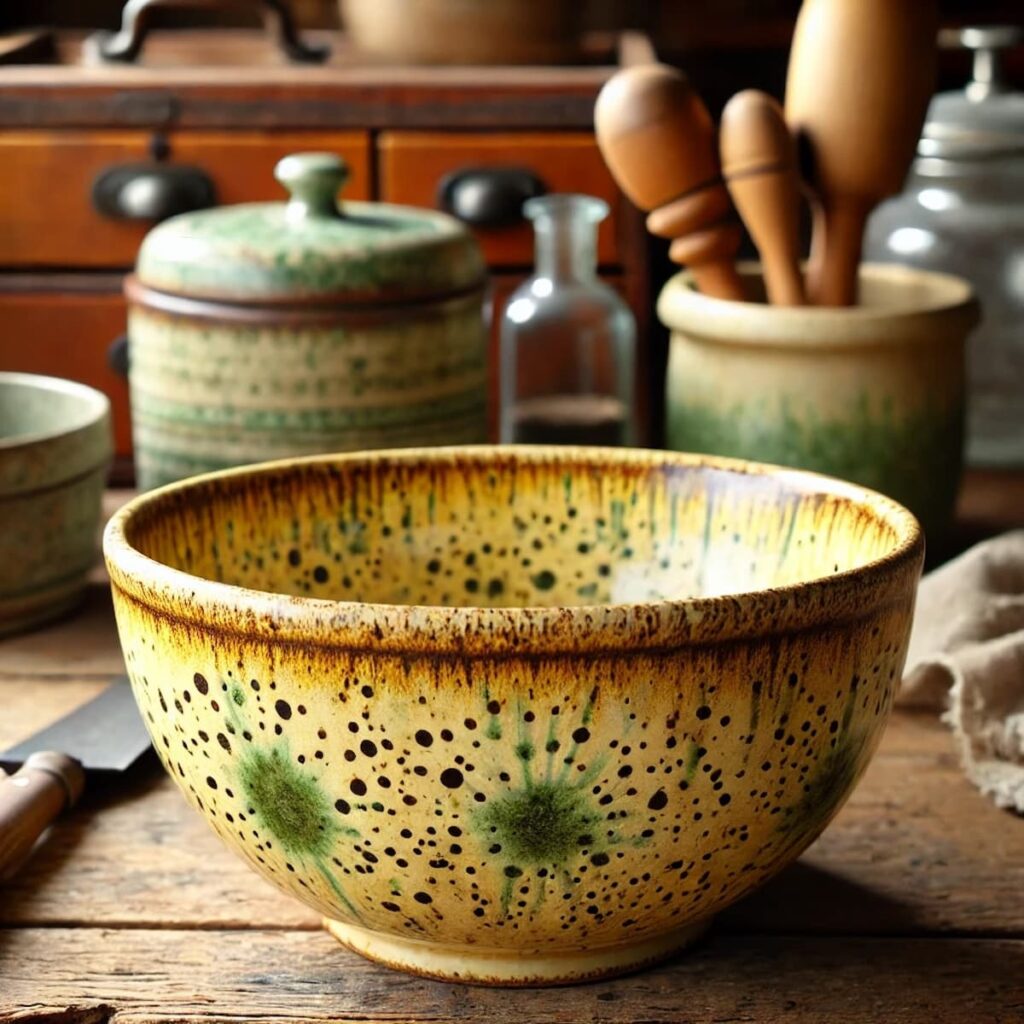
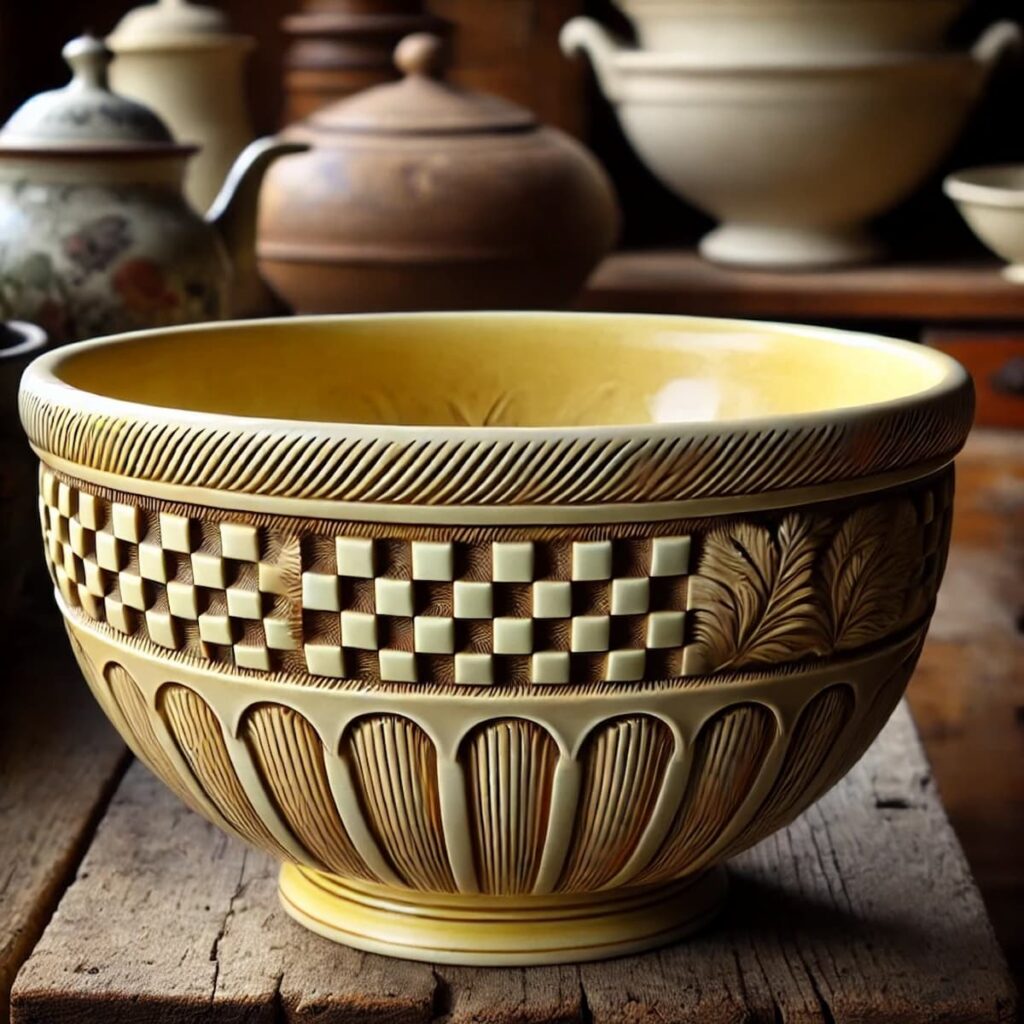
The blue and white striping yellowware is my favorite to collect paired with my mother’s vintage yellowware with white and brown bands.
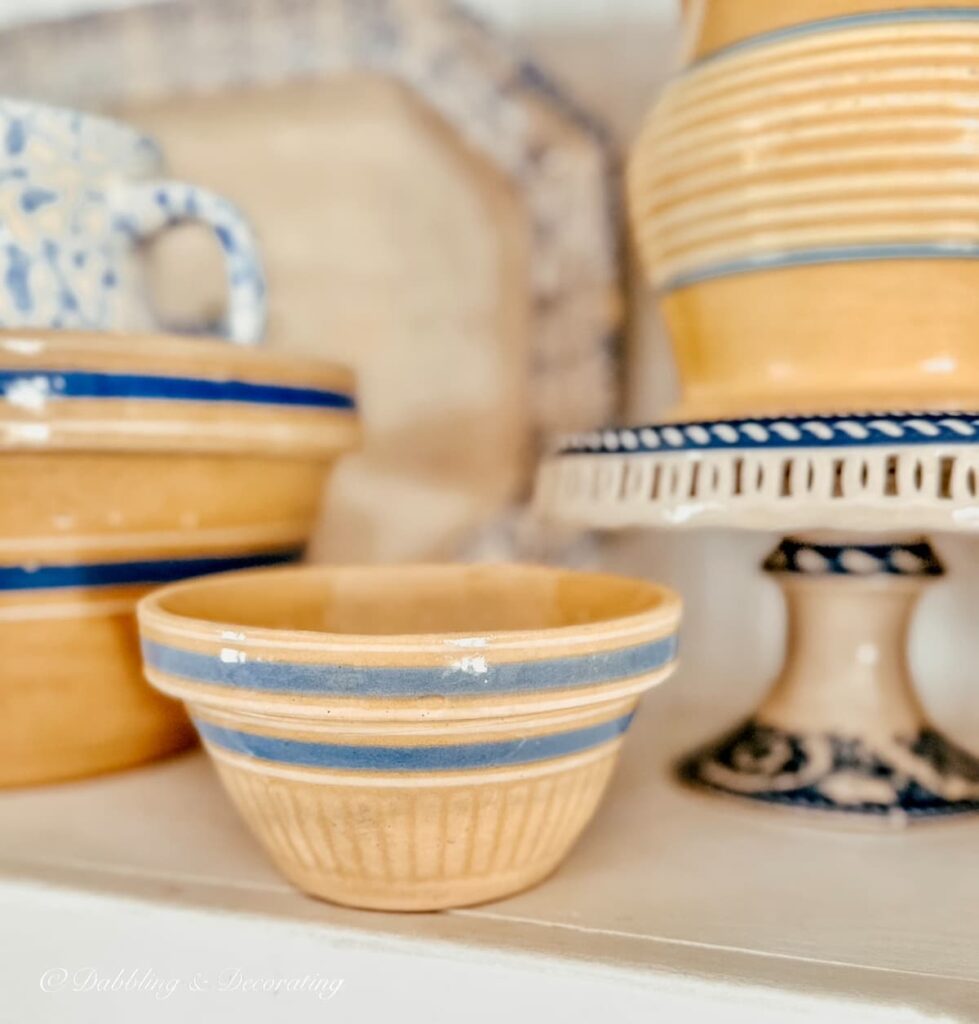

Pro Tip
You may find more inspiration in this Vintage Wall Decor with Retro Chair Collection Ideas post.
Collecting Yellow Ware Pottery
Trends Through the Years
Like all great vintage finds, yellowware has had its moments in the spotlight—and its price tags have fluctuated right along with the trends.
Back in the 1990s and early 2000s, thanks to Martha Stewart’s swoon-worthy collection gracing the pages of her books and magazines, creamy yellow bowls with blue and white stripes became must-have kitchen staples.
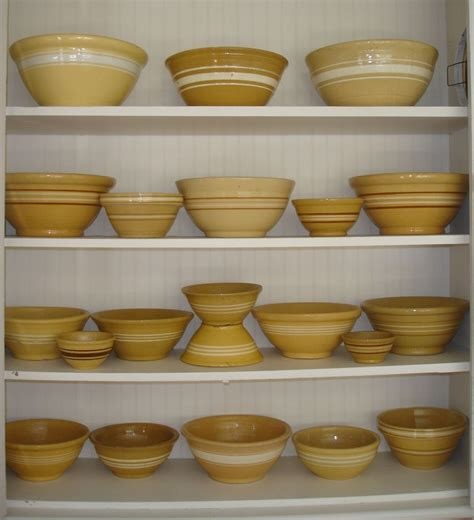
Fast forward to 2015, and Joanna Gaines’ farmhouse fever had us all craving primitive charm, sending yellowware back into the decorating scene in a big way.
But as trends shift, so do prices.
What used to be a $60-$75 splurge at antique stores is now a $30 steal at flea markets, making this the perfect time to start (or grow) your collection.
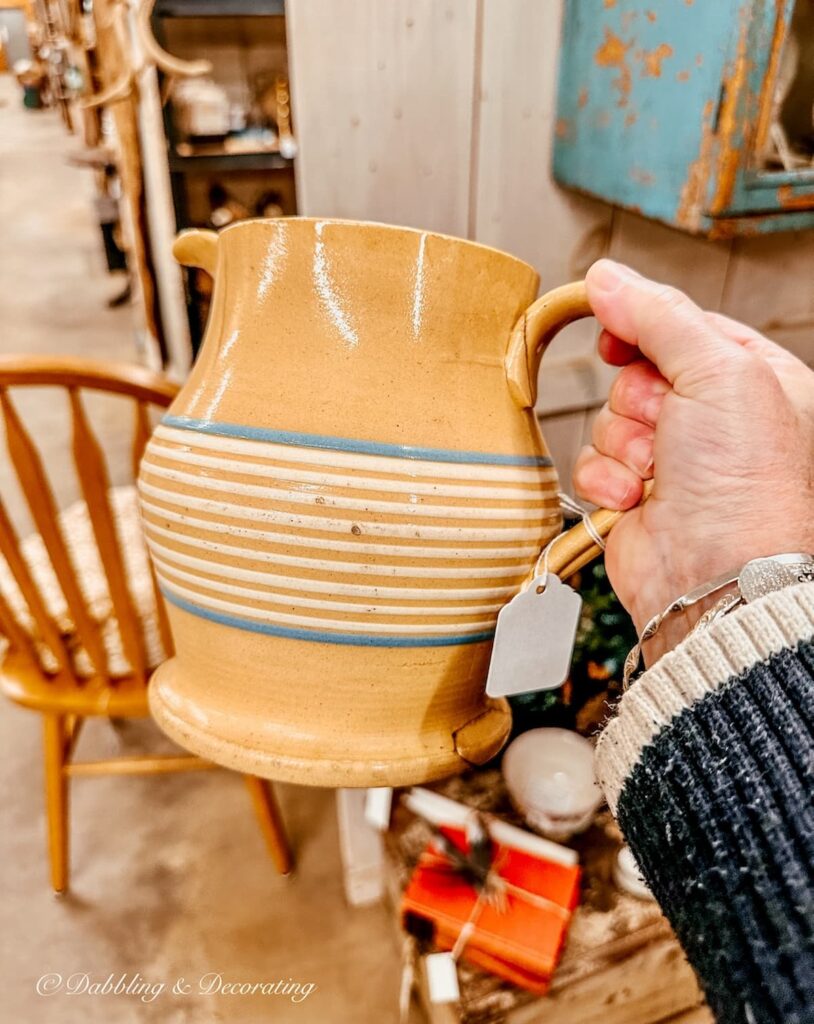
Whether for baking, displaying, or simply admiring, yellowware is a timeless piece of history that never really goes out of style—just like a great thrift store find!
The best part?
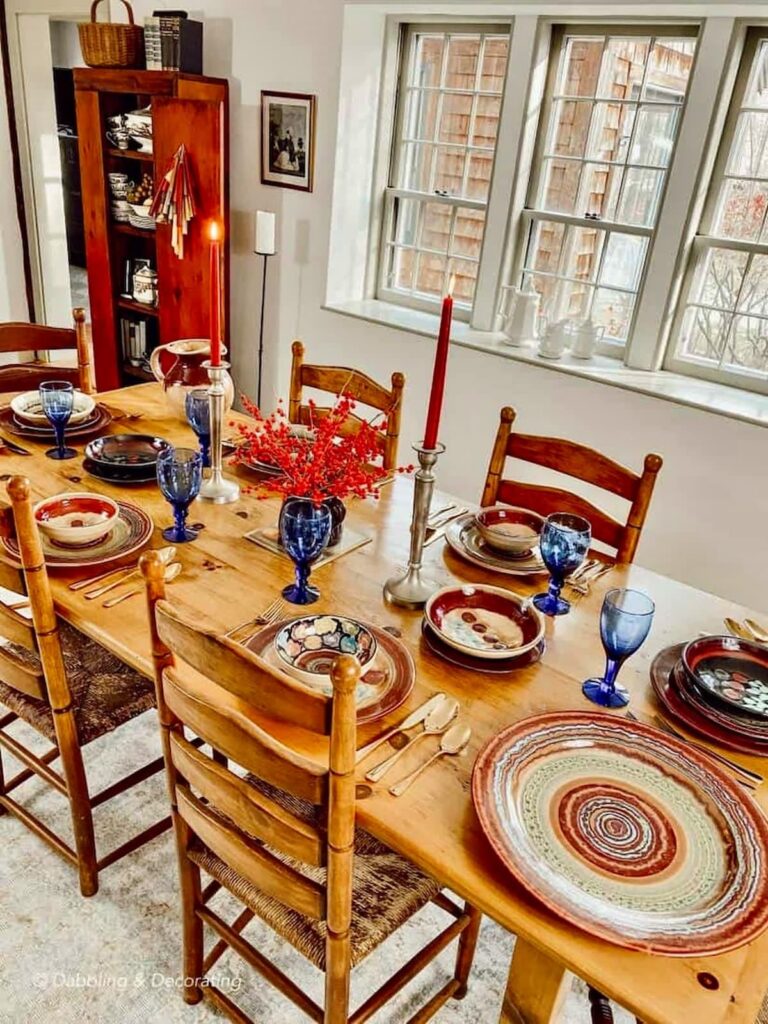
Pro Tip
You may also find inspiration in this Vermont Pottery Imaginative Tablescape post.
Prices have dropped—what used to be a $150 bowl can now be found for $25 to $30, making it the perfect time to start stacking and collecting.
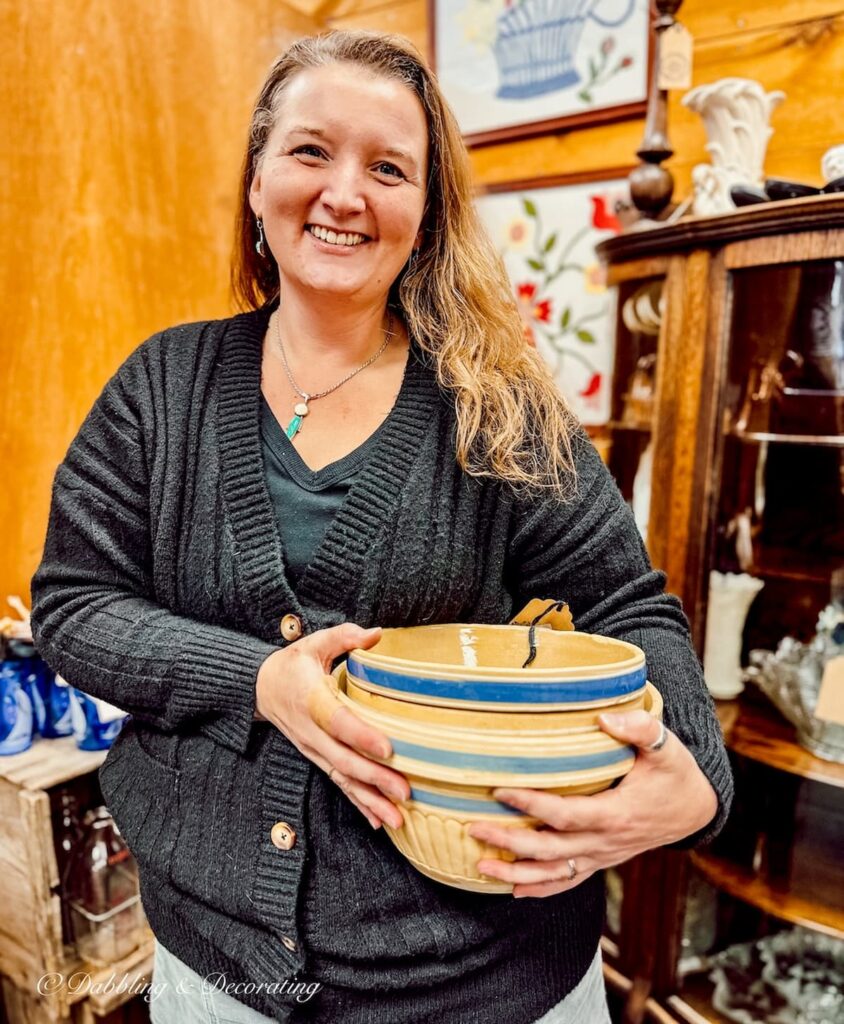
Antiquing for Yelloware Tip
If you don’t spot any yellowware at your local antique store, flea market, or thrift shop, always ask! I almost walked right past a stack of four yellowware bowls with blue stripes the other day—somehow missing them completely. But after chatting with a wonderful antique dealer at Half Moon Home Decor & Designs, I discovered they were sitting right there, just waiting to be found and all four for just $40 bucks! Moral of the story? Before you leave, always ask—you never know what treasures might be hiding in plain sight!
And let’s be honest, you never really run out of room for a good yellowware stack!
Yelloware Decorating Ideas
My Yellowware Collection
I never really set out to collect yellowware, but sometimes the best collections find you.
I inherited a mix of antique yellowware from my mother (you can read more In my My Mother’s Maine Home blog series), but for years, I didn’t think much about it.
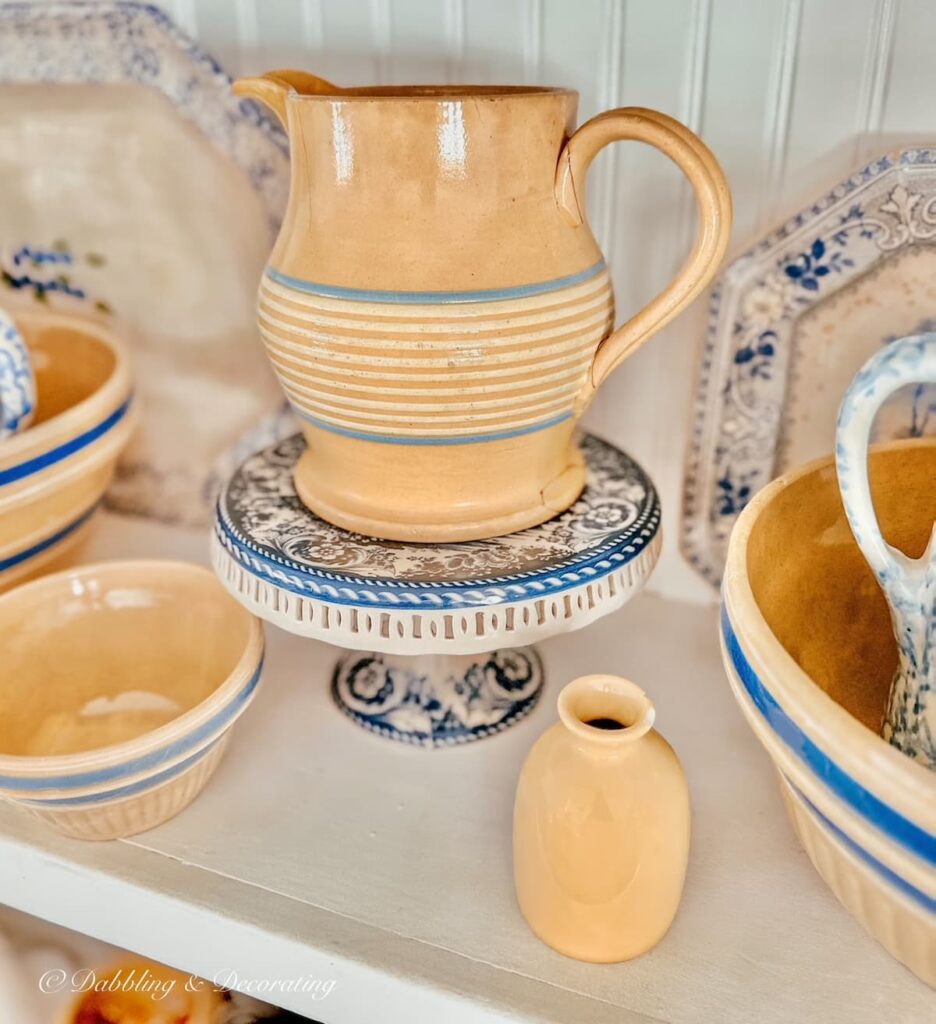
Then, one day, I pulled out a few bowls with blue stripes and placed them on my open kitchen shelving—and just like that, I was hooked.
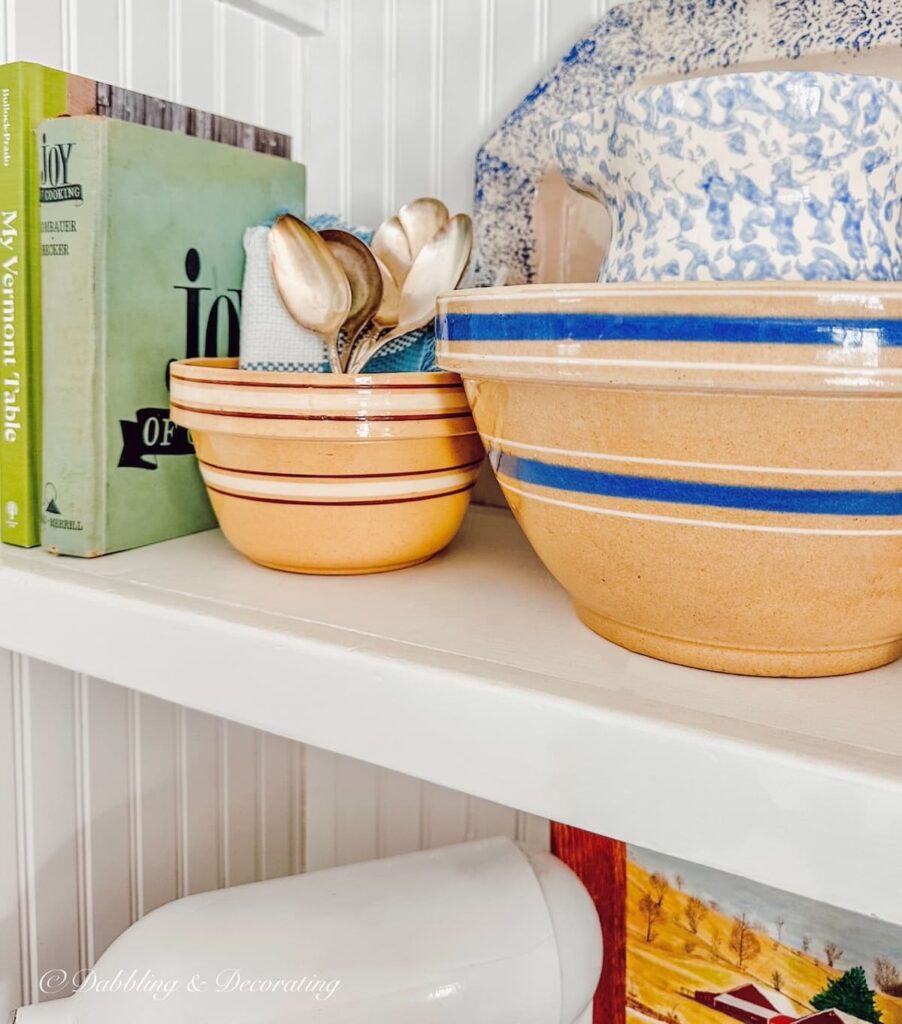
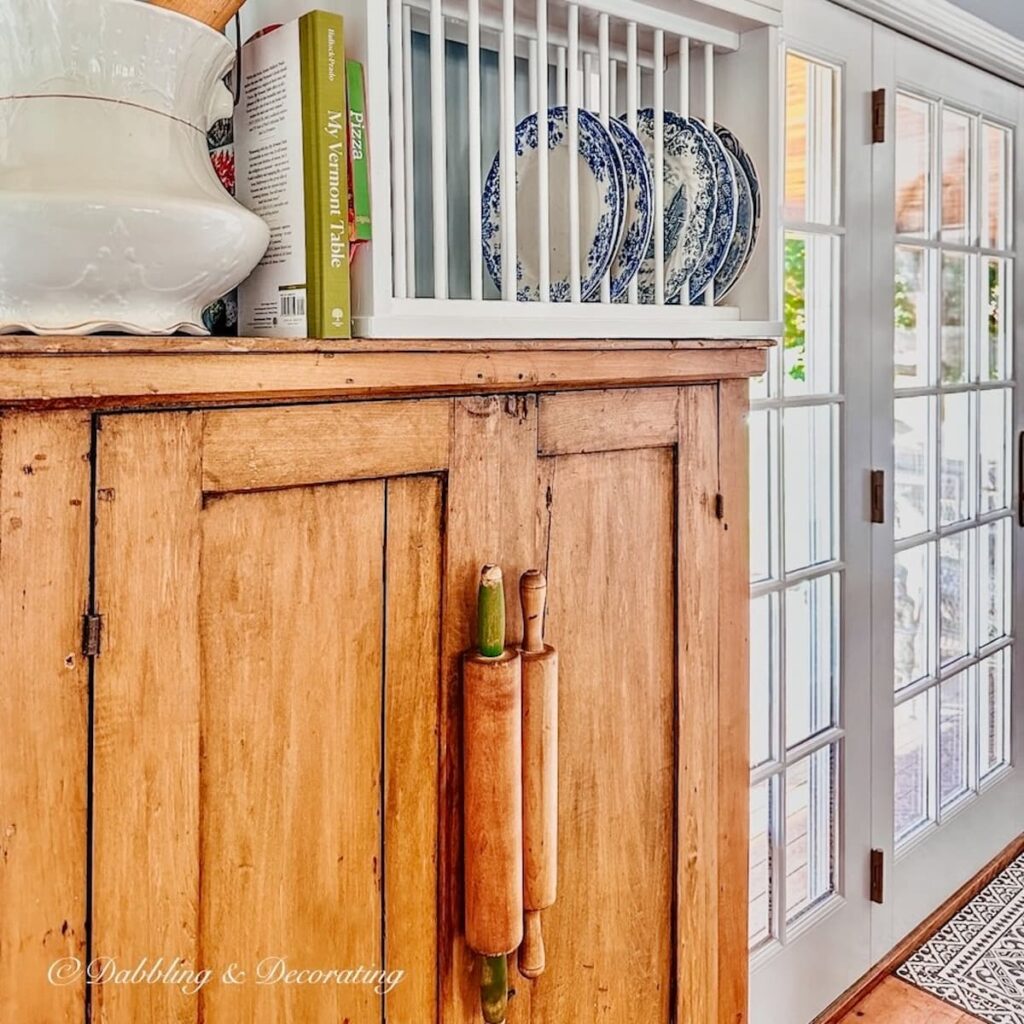
Pro Tip
You may also find inspiration in this Vintage Rolling Pins: DIY Kitchen Cabinet Door Knobs post.
The warm yellow tones paired with the classic blue were so charming, and when I mixed in some of my mother’s plain yellowware, along with bowls featuring white and brown stripes, the collection really started to come alive.
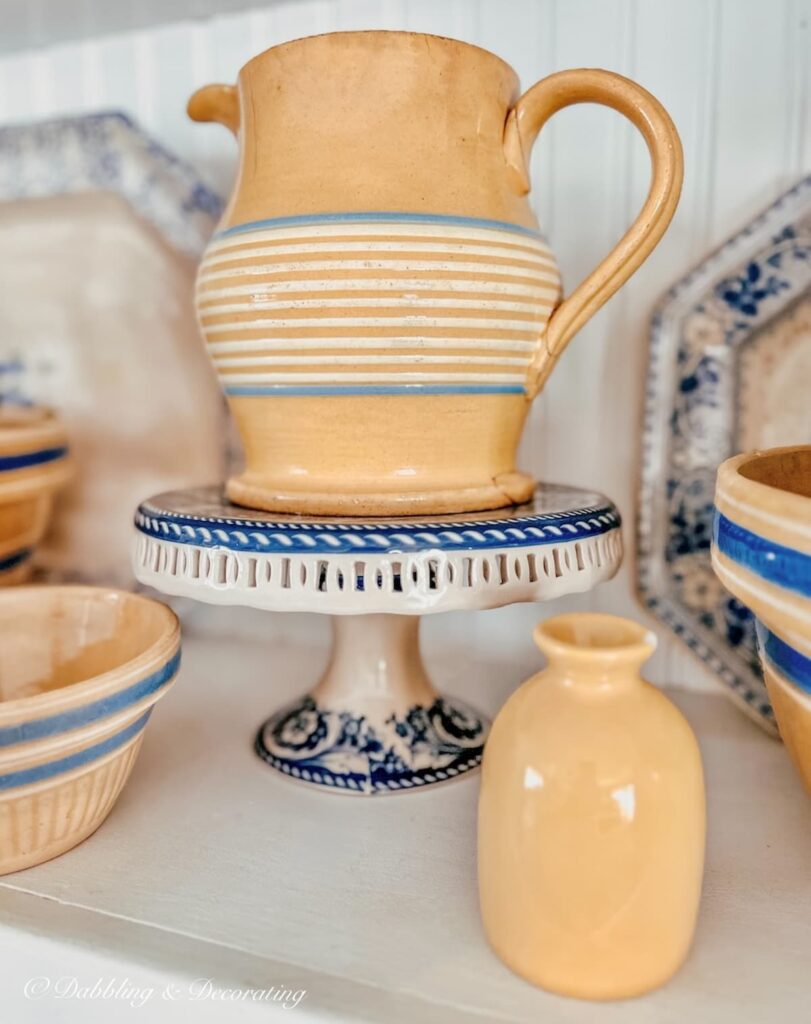
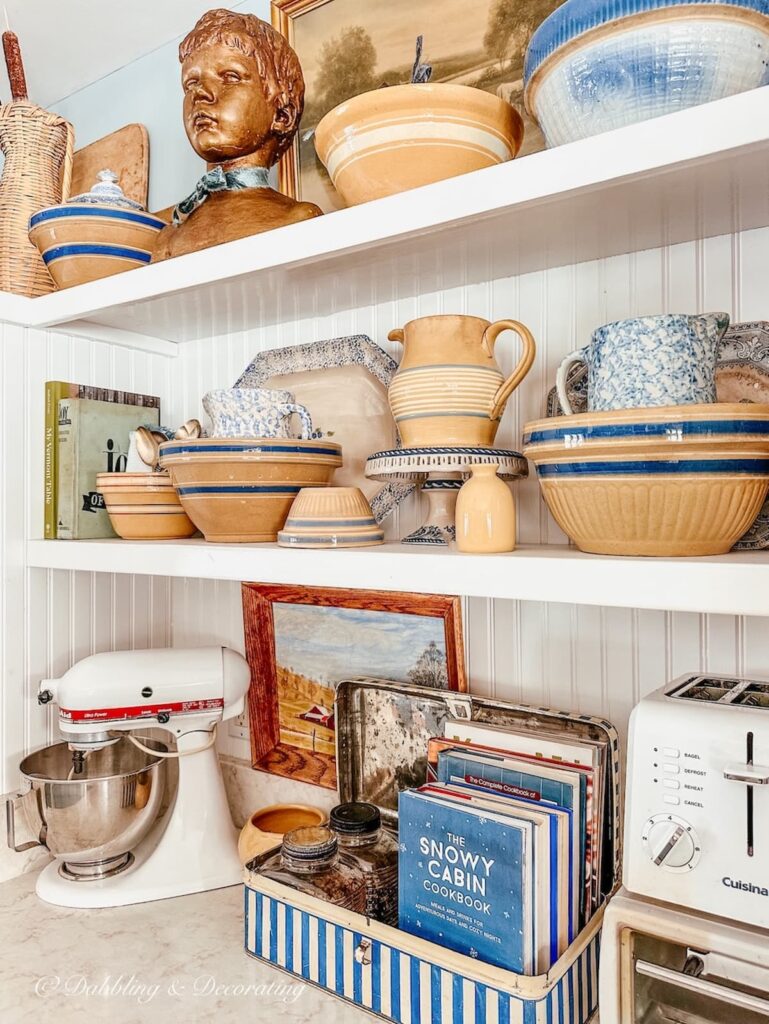
The warm, golden tones of our antique yellow ware genuinely shine against the crisp white backdrop of this open kitchen shelving, creating a display that feels both charming and storied.
I love how the mix of warm medium and late 19th-century pieces—some featuring classic blue and others with white and brown stripes—bring this space a cozy, collected-over-time feel.
To add depth and character, I mixed in my mother’s plain yellow ware bowls alongside rich brown pottery, vintage pitchers, and even a recently thrifted brown bust wrapped with a soft velvet blue bow.
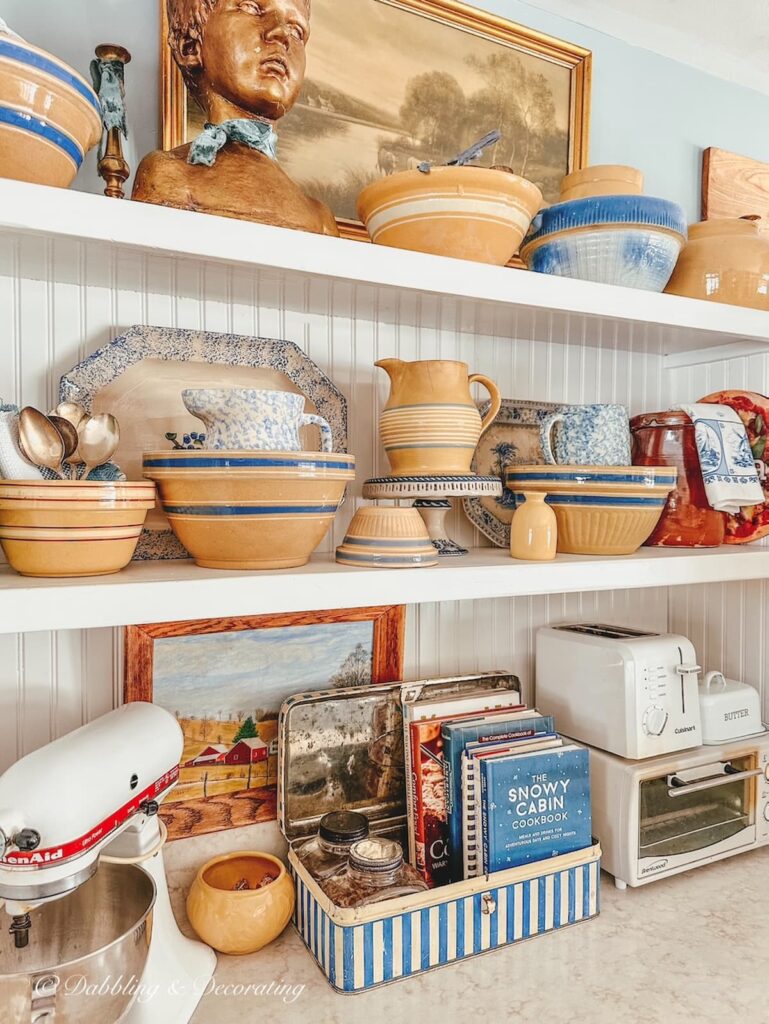
For height and a bit of whimsy, I tucked in antique blue and white cake stands, layered in some table linens, and lined a few well-loved cookbooks into a blue and white striped tin I found antiquing in Paris.
A little Vermont-colored picture from a thrift store and a scattering of cutting boards added just the right finishing touch, accentuating the yellowware’s beautiful texture while bringing some of my travels and family history into the mix.
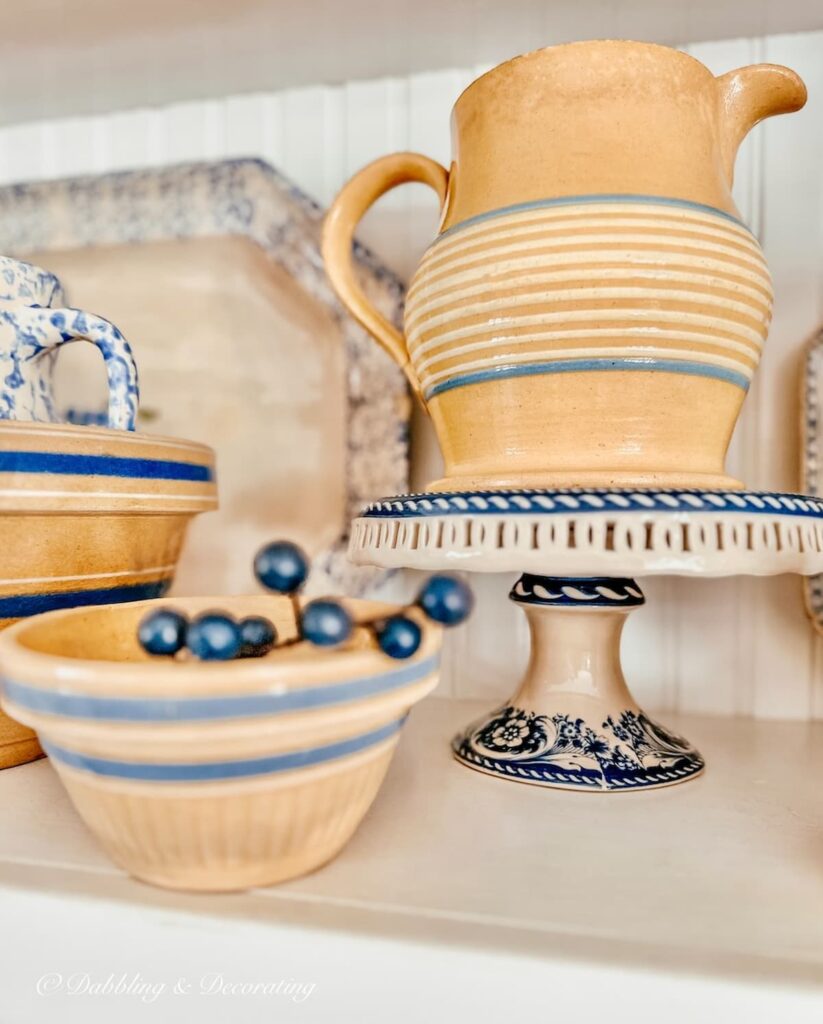
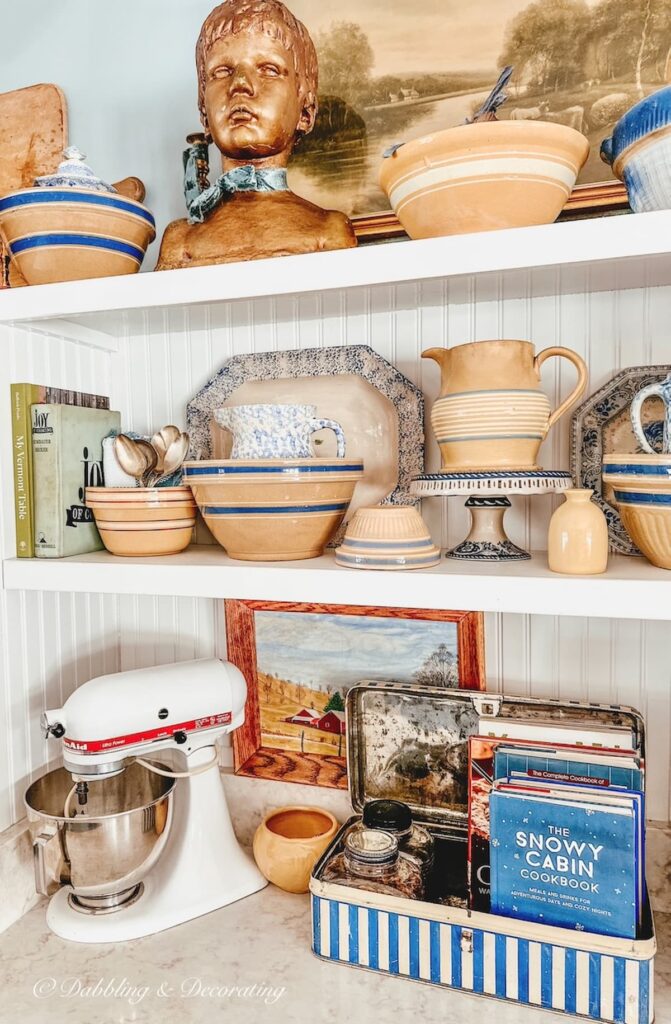
It’s a warm, welcoming display that feels effortlessly vintage and deeply personal!
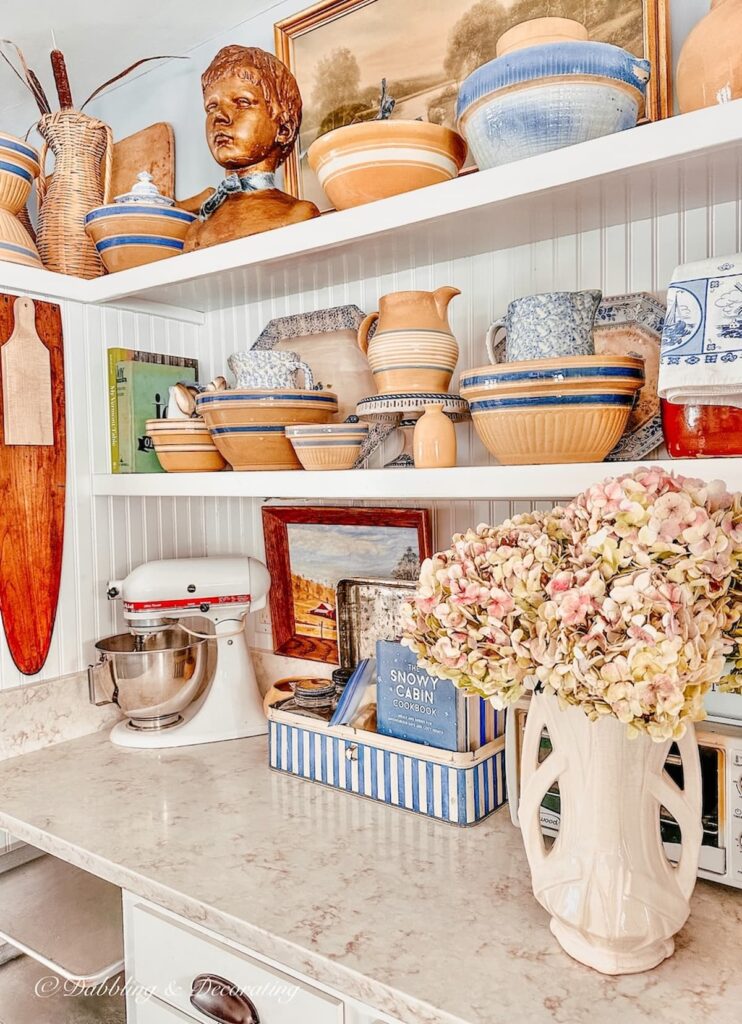
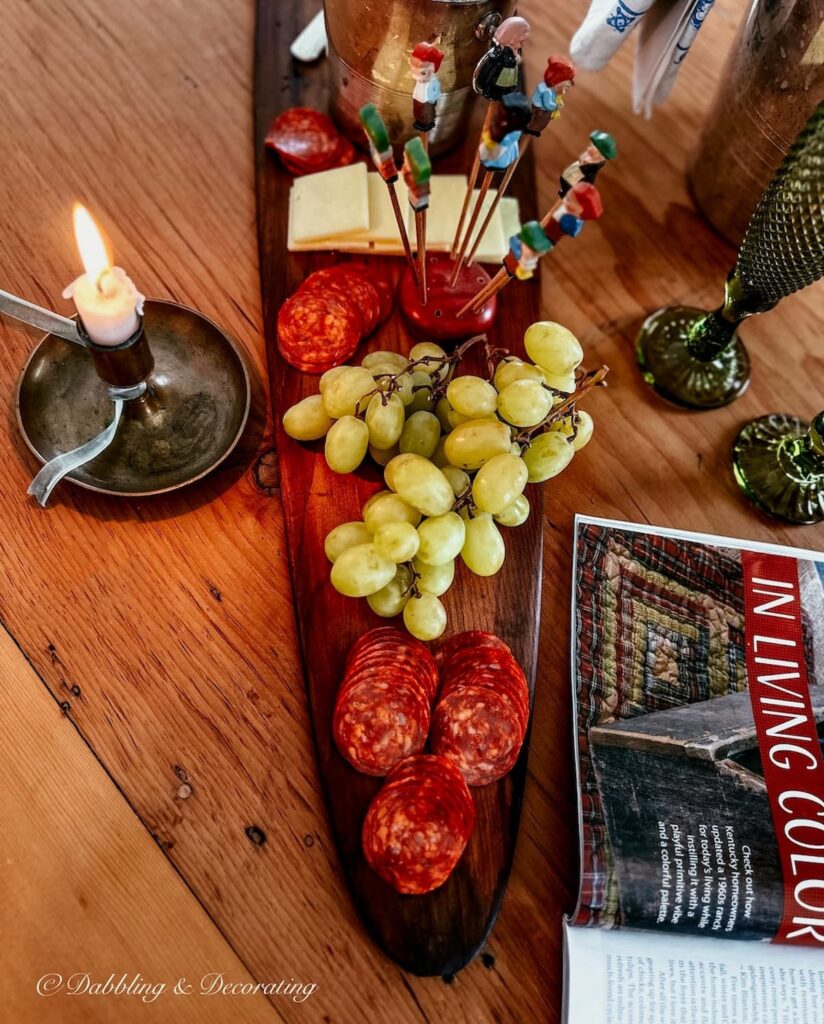
Pro Tip
Do you remember the antique trader stretching boards I found while out Thrifting with the Gals? I turned one into a cutting board and hung it here in the kitchen. See more in this Your Guide to a Rustic DIY Coat Rack with Antique Finds post.
More Yellow Ware Decorating Ideas
Incorporating antique yellowware into your home decor adds a touch of rustic charm and history. Here are six creative ways to style these creamy yellow treasures:
Kitchen Open Shelving
Display a collection of yellowware pie plates and large bowls on open kitchen shelves. The rich yellow bodies and brown stripes of the pieces add warmth and character to your culinary space.
Bookshelves
Intermingle yellowware pieces with books and other decorative items on your bookshelves. The core color of the pottery provides a pleasing contrast to the spines of books, creating an eye-catching display.
Bar Cart
Use a yellowware bowl to hold citrus fruits or bar tools on your bar cart. The surface color and finish of the pottery add a vintage touch to your entertaining area.
Living Room Accents
Place a large yellowware bowl with brown stripes on your coffee table or sideboard. Fill it with seasonal decorations like pinecones, ornaments, or flowers to create a versatile centerpiece.
Barn Decor
If you have a rustic barn or outdoor space, arrange yellowware pieces on a reclaimed wood shelf or hutch. The creamy yellow pottery complements the natural textures and adds a nostalgic feel to the setting.
Dining Table Display
Create a tablescape by grouping various yellowware pieces, such as pitchers and bowls, in the center of your dining table. The surface color and finish of the pottery enhance the farmhouse aesthetic and serve as a charming focal point during meals.
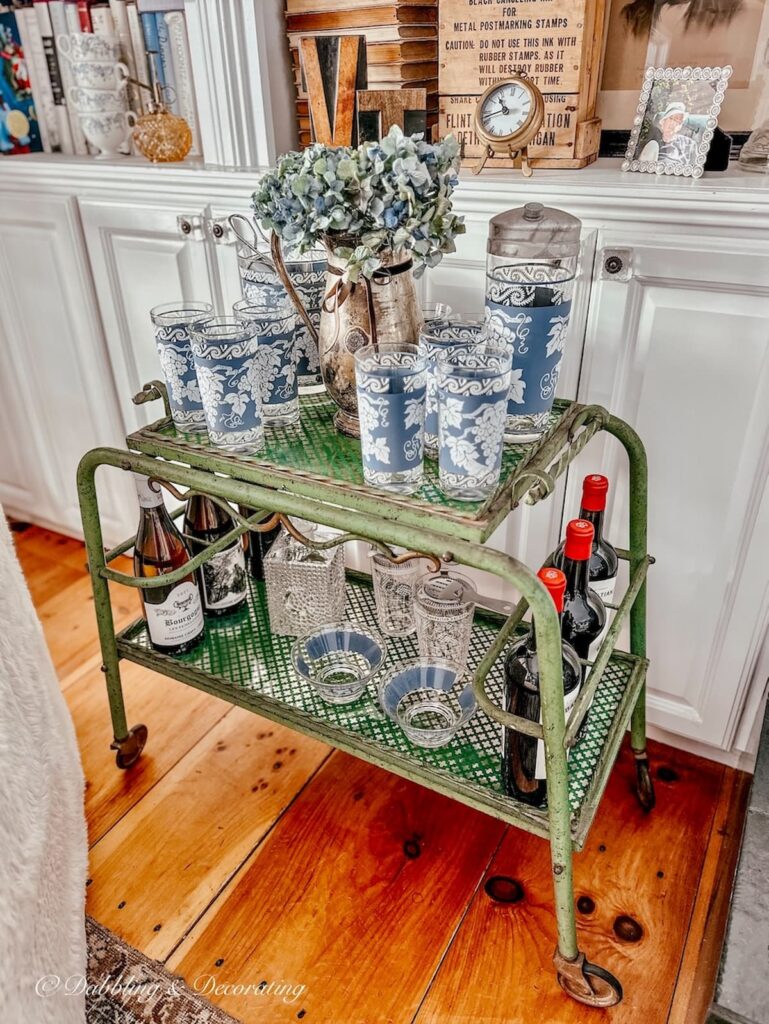
Pro Tip
You may find inspiration in this Antique Bar Cart: 15 Eclectic Ways to Vintage Style post.
Join us for a day of antiquing in Vermont with the gals, where I found the antique yellow ware pitcher with blue stripes:
The beauty of yellowware is that it’s as versatile as it is collectible—whether styled simply with neutral tones or accented with bold blues and warm browns, it always brings a sense of nostalgia and authenticity to a home.
So, whether you find your next treasure at a flea market, a thrift store, or hidden in a family attic, embrace the imperfections, the patina, and the stories these pieces carry.
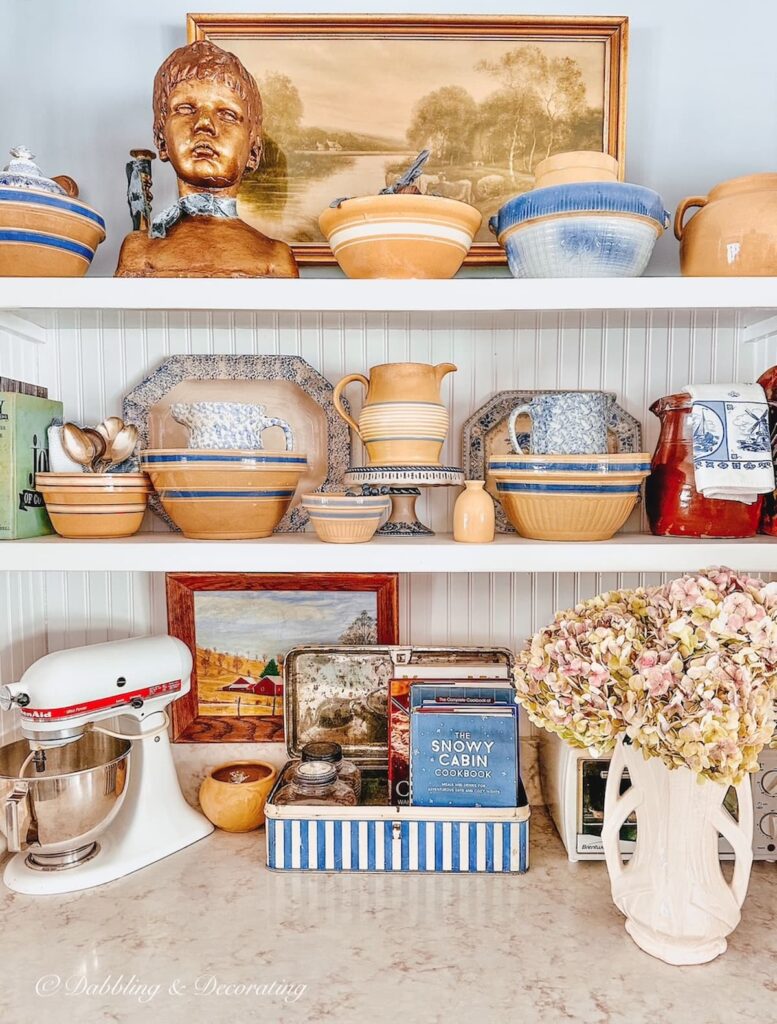
Most Common Questions About Yellow Ware
What are some antique yellow ware items?
Antique yellowware isn’t just about mixing bowls—there’s a whole world of collectible pieces out there! Some of the most sought-after items include chamber pots, pitchers, pie plates, mugs, and even storage crocks. While bowls are the most commonly found, yellowware chamber pots are unique finds that add character to any collection. If you come across a piece in excellent condition, especially with decorative elements like blue, white, or brown stripes, molded patterns, or sponged designs, it’s definitely worth adding to your display!
What is an antique yellowware bowl?
An antique yellowware bowl is a handcrafted pottery piece made from yellow clay, popular from the mid-19th to early 20th century. The body of this rich yellow bowl is typically glazed to enhance its warm, golden hue, and many feature decorative elements like blue, white, or brown stripes, sponged patterns, or molded designs. Originally used for mixing, baking, and food preparation, these bowls are now highly collectible for their rustic charm and timeless appeal in vintage and farmhouse-style kitchens.
What does a yellowware bowl look like?
A yellowware bowl has a distinctly warm, golden hue, ranging from light buttery tones to a rich, deep yellow, depending on the clay and firing process. Typically, these bowls are medium to large in size, with smooth, rounded edges and a glossy glazed surface. Many feature decorative stripes in blue, white, or brown, while others have embossed patterns or sponged designs, giving each piece its own unique character. Refer to photos in this blog post for more details.
How did a potter decorate a piece of yellowware?
Potters used a variety of techniques to decorate yellowware, making each piece unique. One of the most sought-after styles is the blue seaweed decoration, where dark blue glaze was carefully dripped or brushed onto the surface to create organic, flowing patterns resembling underwater seaweed. Other popular decorative techniques included slip banding (applying white, blue, or brown stripes), sponging, molded designs, and engine-turned textures. These embellishments not only added charm but also helped distinguish different makers and regional styles.
How do you decorate yellowware?
Decorating with yellowware is all about showcasing its warm, vintage charm in ways that complement your home’s style. A simple stack of yellowware bowls on open kitchen shelving creates a cozy, collected look, while pie plates and pitchers add character to a farmhouse-style hutch. For a unique display, mix yellowware with white and brown striped bowls on a bookshelf or use a large bowl as a centerpiece filled with seasonal decor. You can even get creative by incorporating yellowware on a bar cart for a fun twist or arranging pieces in a barn or rustic pantry for an authentic primitive feel. Whether styled as a statement collection or subtly blended into your decor, yellowware adds warmth, history, and a touch of nostalgia to any space.
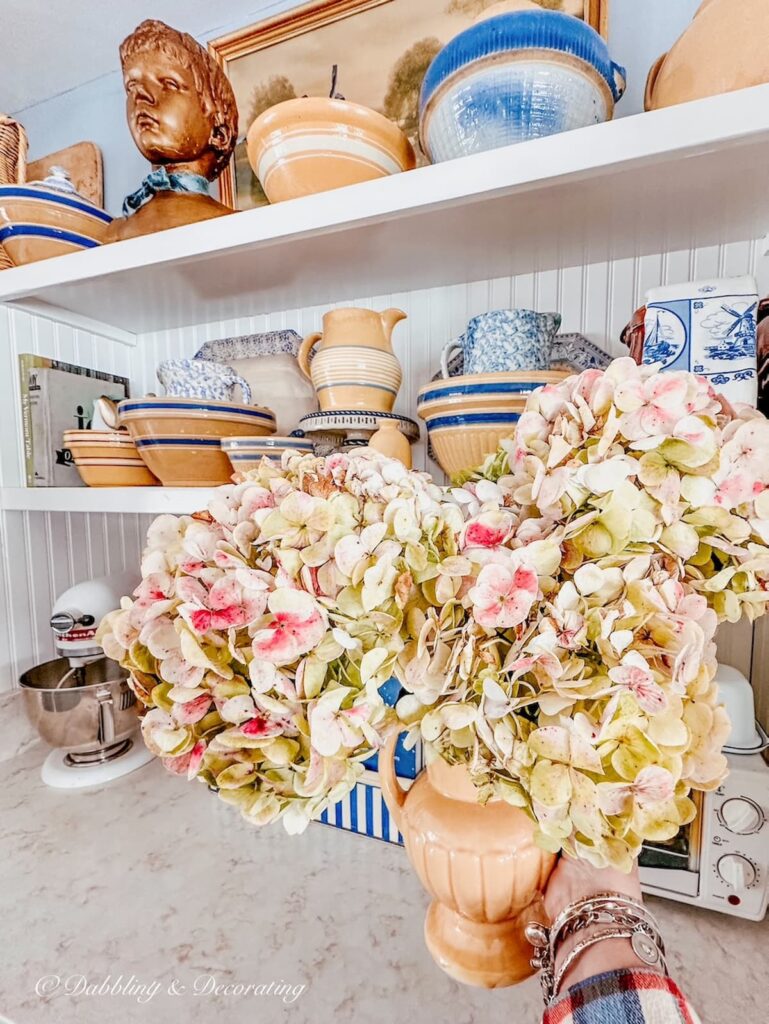
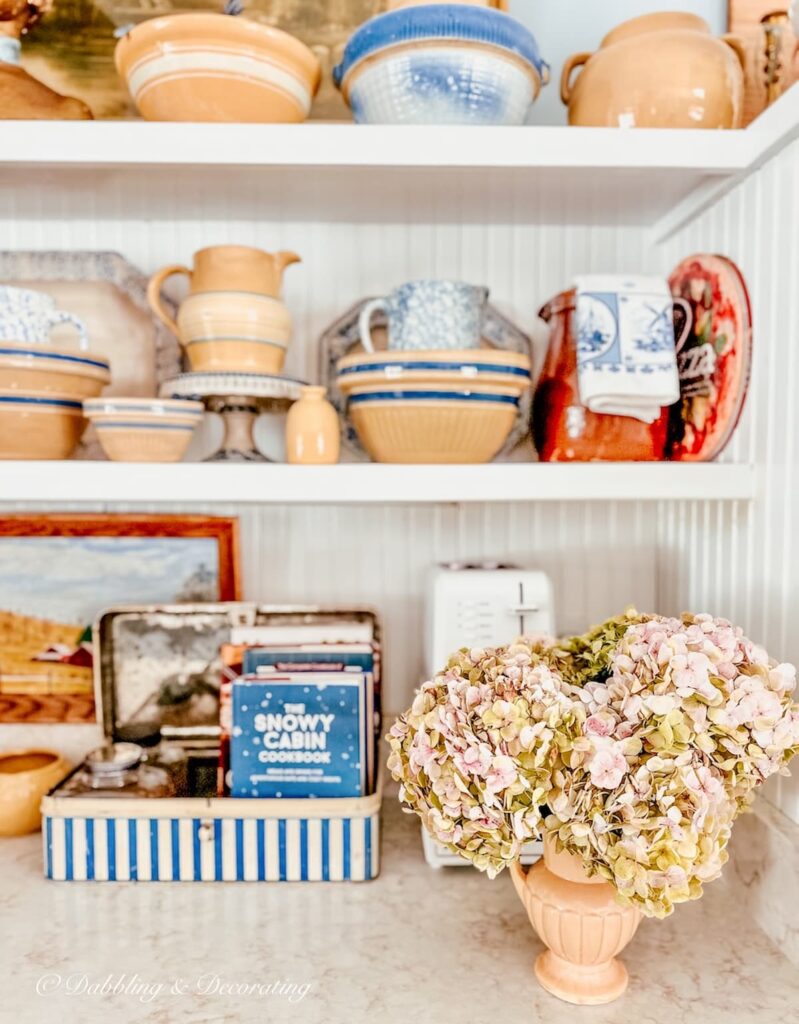
Happy collecting!
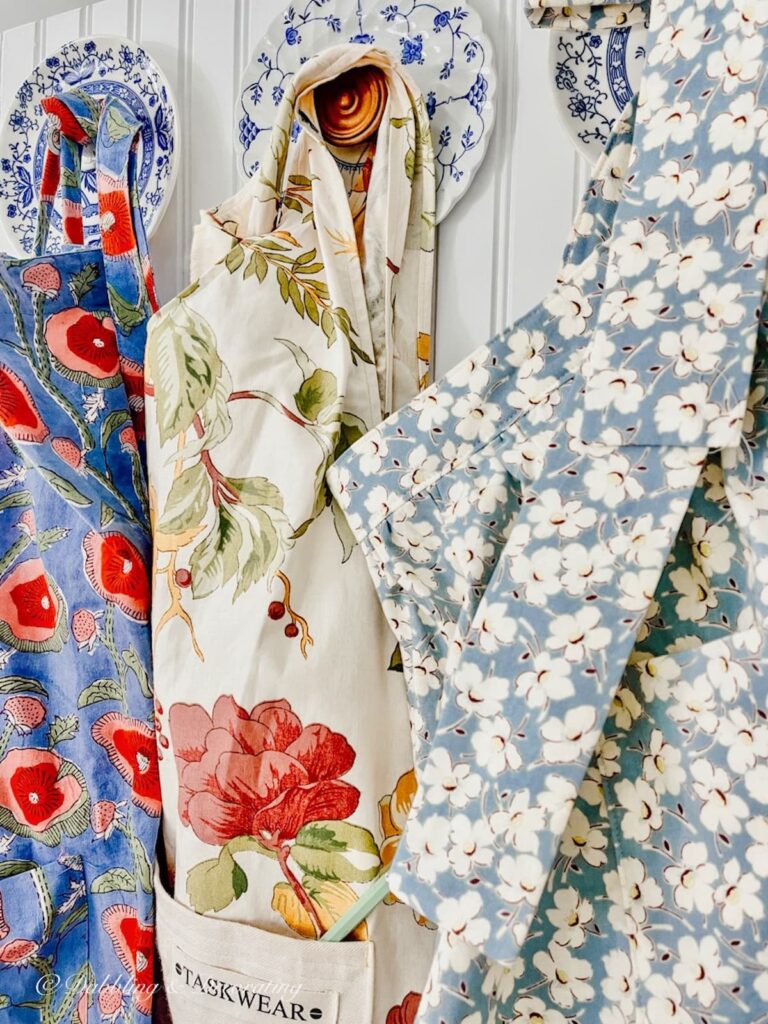
Pro Tip
You may find more kitchen inspiration in this How to Craft Easy DIY Wall Hooks with Decorative Plates post.
Your Guide to an Eclectic Style~
I’d love to hear from you! If you have thoughts, questions, or just want to pop in and say hello, feel free to leave a comment below. And if you have a vintage-loving friend, don’t forget to share this post—they might find a little inspiration here too.
Do you have a flair for all things vintage, too? I would love to see and feature you in our Reader’s Showcase Series. A place for you to share and be recognized for your talents and passion for all things thrifting, vintage, and antique decor-related inspired by your time here with Dabbling & Decorating. Email me at [email protected]
Pin forLater!
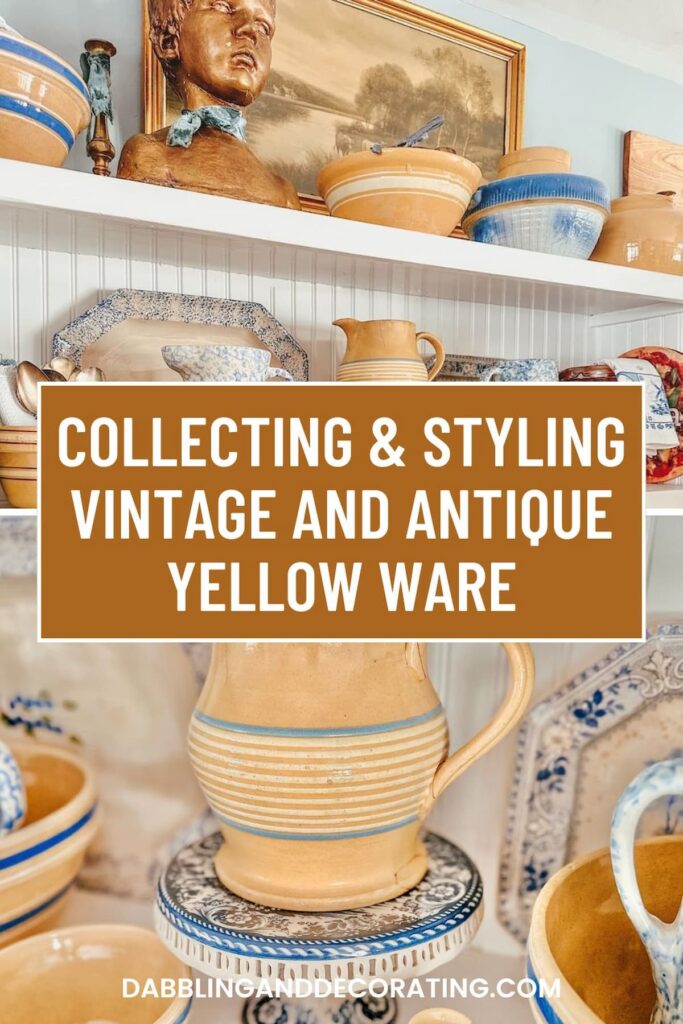
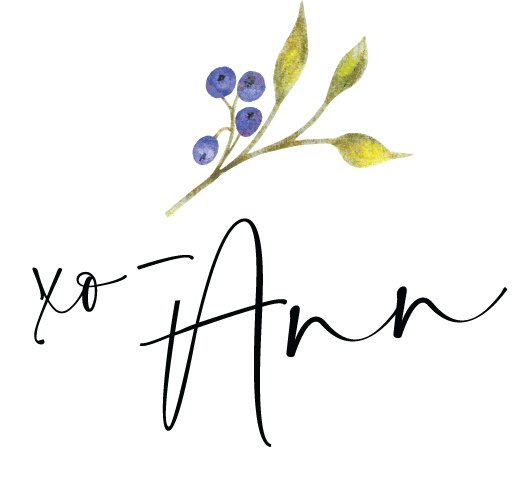
Shop This Post
This post may contain affiliate links, which won’t change your price but will share some commission.
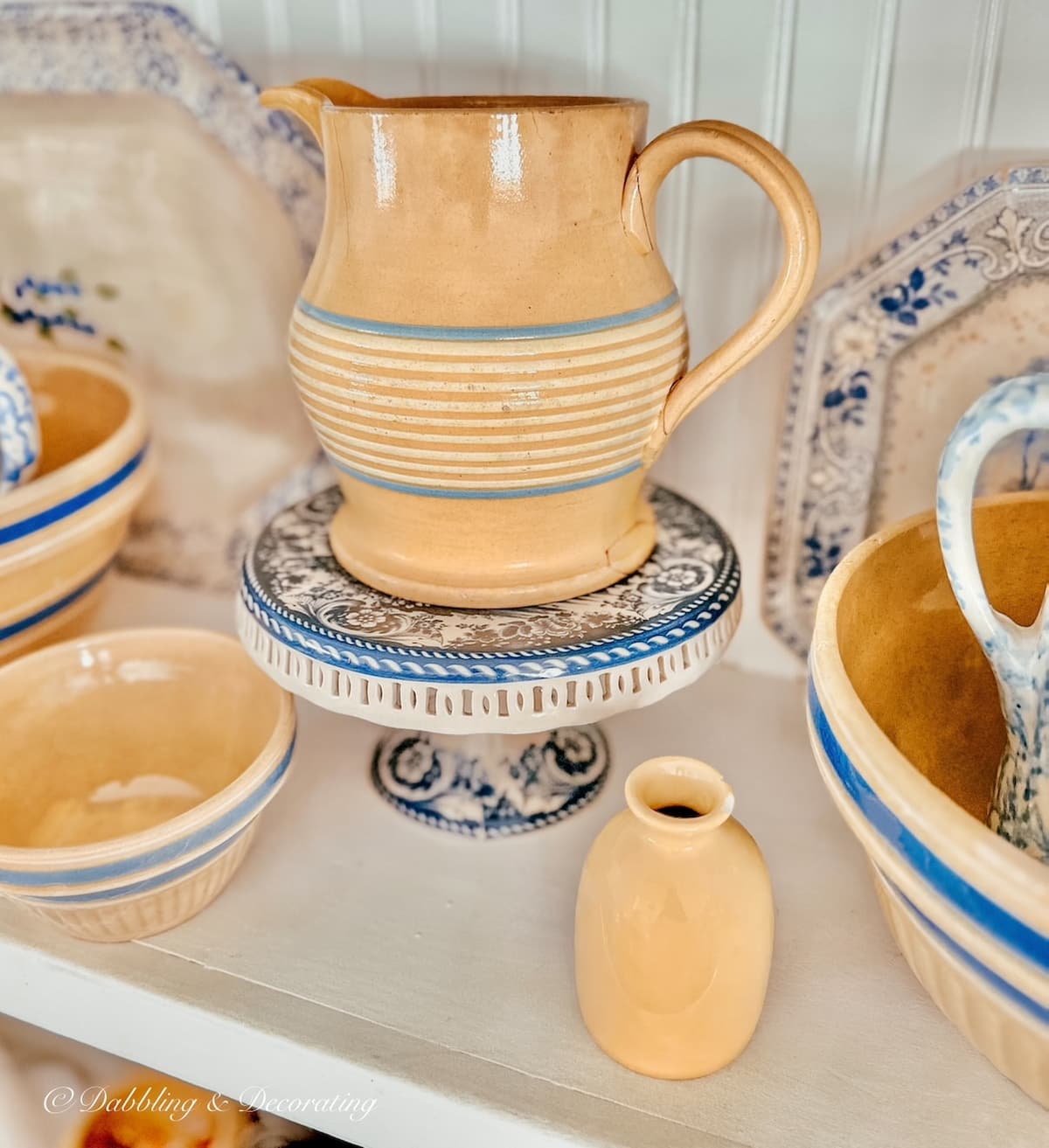

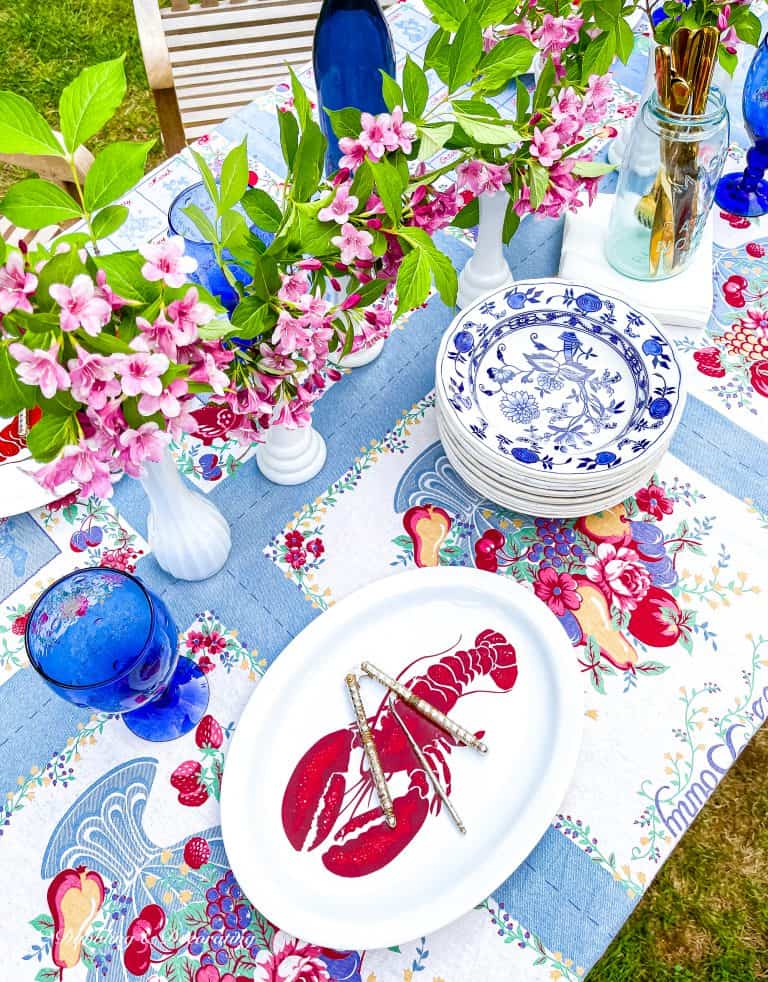
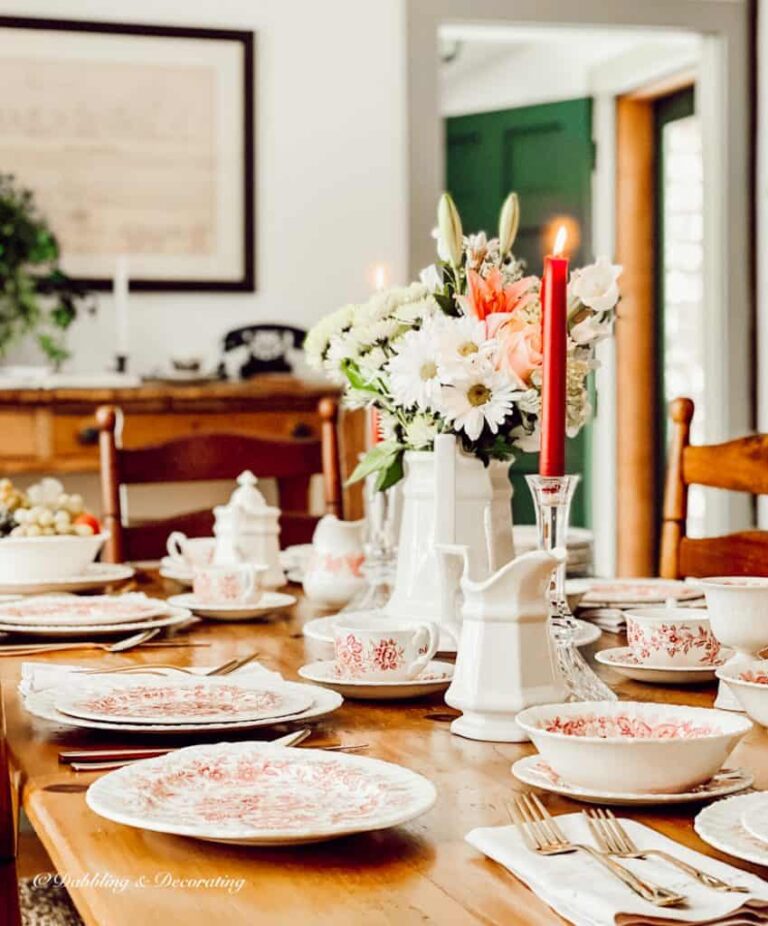
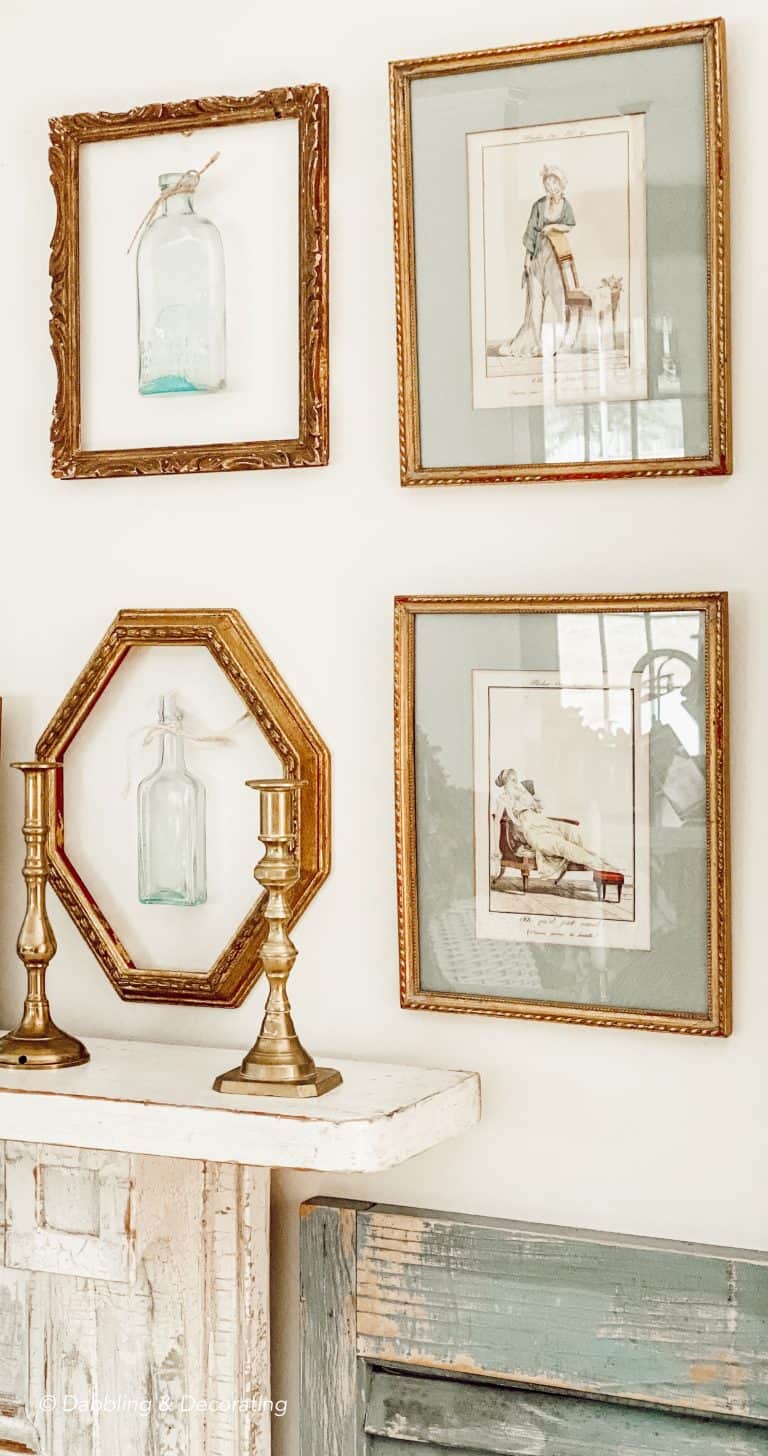
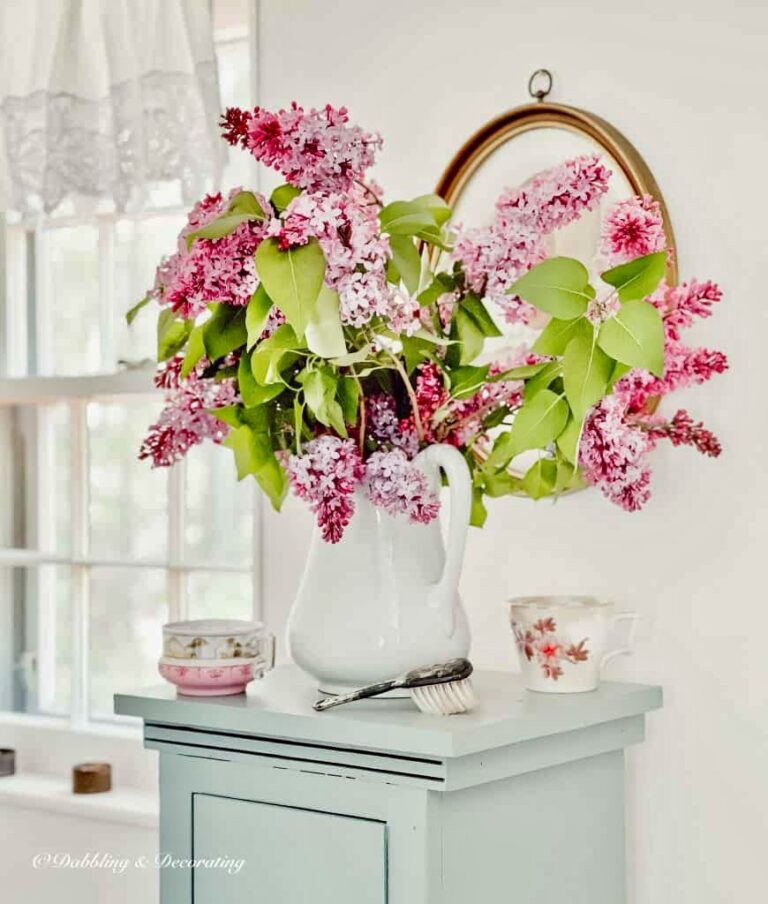
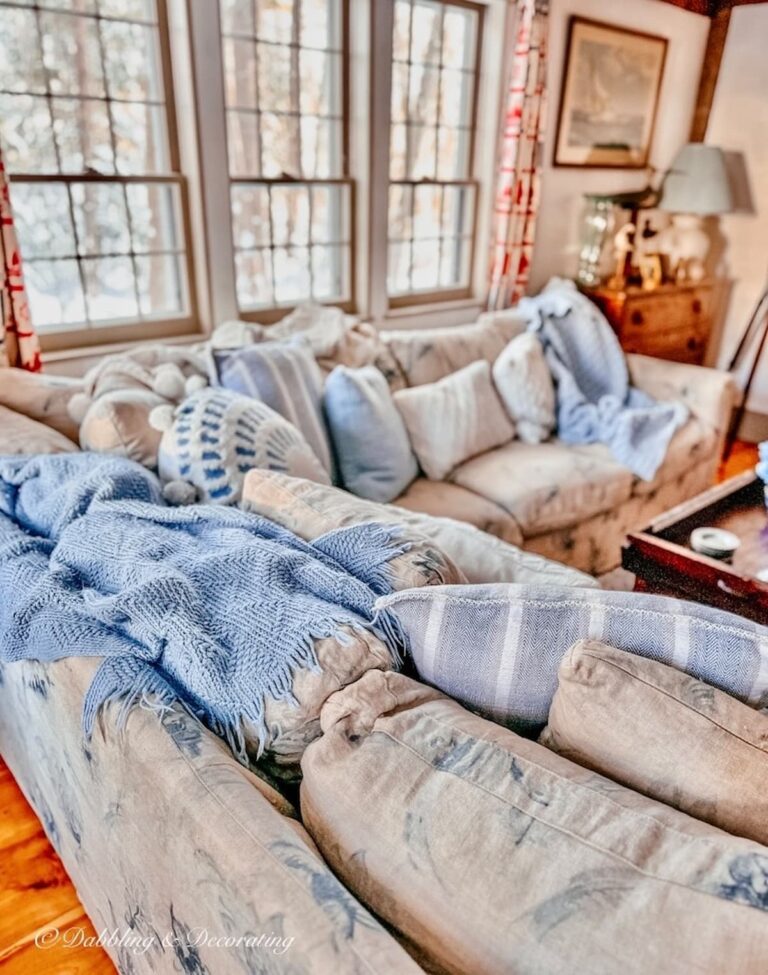
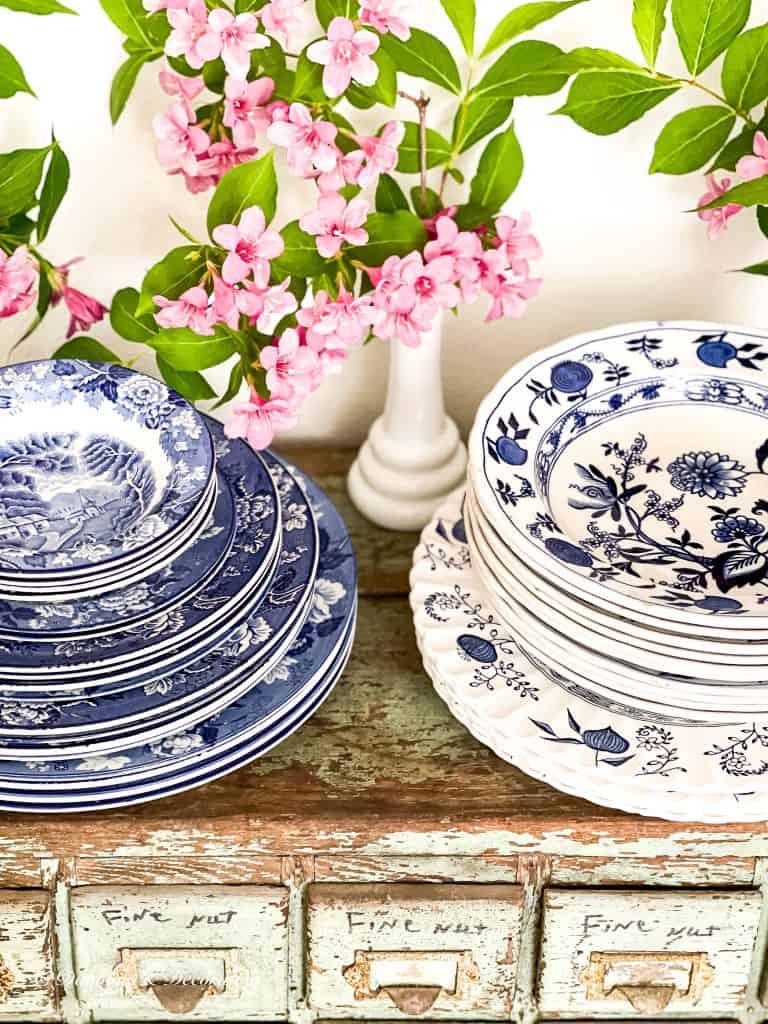
You know this collection speaks to my heart, Ann! And you have styled it all beautifully! Looks like you and Bernadette had a fun day!
Thanks so much Molly, It has such a nice fresh spring twist to it too!
Ann I am always amazed at how much we have in common. I started collecting yellow ware in the 80’s. It was my first collection. Though I have sold a lot of it, I have kept all my favorite pieces. I use it now with a collection of reproduction (I can’t afford the real deal) red ware. They compliment each other oh so well. I too collect Transferware in blue and white, collected mostly in the 90’s and still add to it from time to time. My love for antiques is as passionate as yours, as was my mother’s. I too inherited some outstanding pieces from my parents. Though I live in the midwest one of my favorite places to antique is Maine. I had more fun when my parents and I took a 3 week driving trip to Maine, New Hampshire, and Vermont. They showed me all their favorite haunts. Your blog for me is such a joy, and I never want to miss it. Please stop over to my blog I think you will enjoy it. https://fortheloveofold.com
Shelley thank you so much for your beautiful message, it means so much to me! I’m looking forward to stopping by your blog!